#1930's Bar Aesthetic
Text

Lost & Found, Sharon, PA
#Black and White#Black & White#Old Fashioned#1920's#1930's#Bee's Knees#Alcohol#Bar#Barcore#1930's Bar#History#historicalcore#historycore#historical#Historicalcore#Drinks#Alcoholcore#Aesthetic#Alcoholcore Aesthetic#Drinks Aesthetic#Historicalcore Aesthetic#Historical Aesthetic#Historycore Aeshtetic#History Aesthetic#1930's Bar Aesthetic#Barcore Aesthetic#Bar Aesthetic#Alcohol Aesthetic#Bee's Knees Aesthetic#1930's Aesthetic
3 notes
·
View notes
Note
So, bear with me, this is gonna be a bit wild.
Setup (Things that we know from the games):
Fallfest had canonical appearances in 1970 and 1983
The FNAF 4 house can be seen on a hill overlooking the Fallfest 1983
A car that has purple aesthetics similar to the purple car of Midnight Motorist and Later That Night is there
Fallfest (as of 1983) seems to be a Carnival consisting of a barn (HW1 and HW2), a Carousal (HW2), and a Shooting Gallery (HW2)
Mystic Hippo and Carnie also fit the carnival theme (as fortune tellers were popular in carnivals and carnies... well, obvious), and both have Henry's animatronic hinged design.
Adjacently, several of the subtitles mention a 'Carnival Nurse' as well in the Patch game of HW2
Glitchtrap seems to be a handsewn costume that is implied to be William Afton's first official Spring Bonnie costume
Fredbear singing show was a thing in 1930's, with a dancing bear that would be around in Carnivals
Mrs. Afton has never been seen in-game or stories, barring the STAFF bot recreation in Security Breach (where she sits at the head of the table and William Afton looks like he's dressed as a carnival ring master), and possibly is represented by Clara in Immortal and the Restless, as well as maybe Balora.
Balora has the appearance of a Ballet Dancer, who also did tight-rope stunts in circuses and carnivals.
Clara sets her and Vlad's house on fire when she grows sick of Vlad's lies
The fire that hits the Carousal starts at the barn of Fallfest 1983 (and may be tied to the Shooting Gallery also going up in flames)
Charlie and Crying Child are both implied to have died in 1983
William Afton is British (I promise this will matter)
The Theory:
In 1930's USA, Fallfest has become a yearly tradition in Hurricane, Utah, headed by an average midwestern family who were popular in the town. This Fallfest included Fredbear, the dancing bear. This carnival would take place on their family farm, and included games in their own barn.
At some point in time, possibly 1970, an aspiring British showman - named William Afton - arrives from the UK to look for entertainment possibilities in Utah, where he met a woman (referred to as Clara for convenience) who was running Fallfest in the city as part of generations of her family, while also doing performances as a tight rope dancer.
He shortly married her soon after and had 3 kids: Micheal Afton, the Crying Child, and Elizabeth Afton.
Working at the Fallfest was an engineer named Henry Emily, who was building animatronics for the carnival, and worked with William to design the first of their characters: Spring Bonnie, Fredbear, and what would eventually be known as the Mediocre Melodies (and maybe Chica, Sun, and Moon as well).
The popularity of these mascot characters made the Aftons and Emily's a great amount of profit from each Fallfest and enough of a push to start their own Fredbear Diner, where William and Henry created the Springlock Suits/Animatronics.
TV shows were made, lunchboxes were made, masks were made, merch was doing good.
Over the years, rumors would surface of the mascots coming to life and stealing children, but they were baseless rumors. Still, enough to scare the Crying Child - who had seen his own father putting Henry into a suit for work - and likely may have inspired the idea of calling Fallfest a 'Spookfest' for Halloween by the public.
In 1983, Micheal Afton and his buddies (including Bonnie Bro/possibly Cassy's Dad) stuffed the Crying Child into Fredbear's mouth and put him into a coma, where he would eventually die from his injuries.
In 1983 of that year, William Afton - mad with grief and possibly rage/jealousy at Henry - found Charlie Emily (Henry's daughter) locked up outside. After luring her with the promise of help, he violently killed her in a rage and drove off.
In 1983, as Fallfest approached, William is confronted by Clara. Henry had his suspicions about his friend, and Clara had noted the timing of William getting home that day and how suspicious it was that they would both lose a child in the same year at the same place.
William refuses to admit to anything, gaslighting her, pointing out that there is no evidence. Their marriage goes rocky, both of them angry and grieving, and Clara notes how empty the house feels despite it still being full of people (William retreats into his work, Micheal is traumatized, and Elizabeth is too young to understand what is going on).
In 1983, during the Fallfest of 1983, Clara Afton finds evidence of William's murder of Charlie in the Barn setup for the patrons. Maybe it was a weapon. Maybe it was something led to her by the spirits or the Shadows of William's Dark Deeds. Maybe it was her son, saying 'It's Me' in a way only she could figure out.
Perhaps William is there, the two of them having one final confrontation.
In 1983, Fallfest, Clara sets the barn on fire in an attempt to kill herself and her husband. Out of shame? Out of anger? Out of fear if he tells her his plans for putting their dead son back together?
Maybe none of it. Maybe all of it.
In any case, the fire spread, engulfing the barn and hitting the Carousel and its occupants. Panic ensues as Fallfest goes up in flames, animatronics and games burning... and William Afton escaping with his life.
Clara, does not.
(Obviously this is all just a theory, but I wondered why Mrs. Afton seems to be simultaneously left out of the story beyond animatronic/cartoon parallels, and that at least one of those parallels had her burning their house down. Obviously a barn isn't a house, but it's interesting that we see the fire start at the barn in 1983, close to the FNAF 4 home, and Clara is the only female character who sets fire to a home.)
(Also, obviously, if one believes in the Mrs. Afton running Fazbear now - since the way it's structured is meant for family businesses - then this goes against that theory, barring William Afton also resurrecting her in some capacity but I don't want to get into that.)
I don't necessarily agree with certain things, and it's kinda hard for me to have opinions on other things since we don't have a ton of evidence for what happened there, but it's interesting to think about.
#five nights at freddy's#fnaf#fnaf 4#william afton#michael afton#mrs. afton#cc afton#fnaf crying child#evan afton#elizabeth afton#henry emily#answered asks
40 notes
·
View notes
Text
Vintage Parker Vacumatic Gold Web Double Jewel Fountain Pen

Vintage Parker Vacumatic Gold Webbed Fountain Pen
- Stunning golden web marble amber semi-transparent barrel
- Double jewel
- Vacumatic lock-down filler
Parker vacumatic fountain pen - Up here is a vintage Parker Vacumatic fountain pen, which was manufactured in USA circa 1930s.
The pen is in nice condition. The pen illustrates GOLDEN WEBBED pattern, and it is amber SEMI-TRANSPARENT, highly sought after, rare, and beautiful. You can see the ink flow inside the barrel. I am sure that you will not be disappointed.
The pen bears double jewel at the barrel end.
It has a Parker 14ct solid gold nib. A new vacumatic sac has been fitted. The lockdown filling system is special and in working order.
This Parker Vacumatic has a classic elegance and has been produced to the highest standards of craftsmanship, technology and aesthetics. The pen has been serviced and tested for full functionality. This is rare and very much sought after, of such a collectible and vintage pen in excellent condition.
The Parker Pen Company was founded in 1888 by George S. Parker, whose mission was to manufacture a better pen. The Parker Pen Company's tradition epitomizes the highest standards of craftsmanship, technology, and aesthetics. From the 1920s to the 1960s, Parker was No.1 in worldwide writing instrument sales. The Parker Duofold is one of the most recognizable and enduring fountain pen designs. Launched in 1921, the pen was a phenomenal success and put the Parker Pen Company squarely into the front rank of fountain pen manufacturers. Duofold remain popular in Europe being produced well into the 60s in varying sizes and colors when it was revived in the 80's once again as Parker's Flagship model.
In 1932, Parker began test marketing the next generation in fountain pens, the Golden Arrow. This radical new pen featured a compact plunger-operated pump filler that nestled at the back end of the barrel, eliminating the space-hungry pressure bar and sac. The Golden Arrow was later renamed as Vacumatic. The Vacumatic went on the market in 1933; and discontinued in 1939, due to the introduction of new Aero-metric filler.
Parker pens were frequently selected to sign important documents such as the World War II armistices, and commemorative editions were sometimes offered.
You can also view our item on Trumblr.
Read the full article
0 notes
Text

from servicing cars to roasting and serving coffee
[Madcap Coffee]
Once a neighborhood body shop, our Fulton Street roastery and cafe was renovated while maintaining the original 1930’s industrial charm. The well-worn aesthetic of original brick contrasts with the contemporary coffee bar. And, when the weather is nice, we open up the garage door to let the sun in. We're definitely looking forward to those nice weather days.
2.27.23 • Facebook
1 note
·
View note
Text
Queer Metalhead History
It’s time for a brief lesson about the history of queerness and metal music. That’s right, the metal and queer communities are old friends and allies.
So, the leather community has been around since the late 1920′s/early 1930′s, but leather bars specifically became more popular in the late 1950′s. And you know who was hanging out at leather bars? Gay bikers and veterans, who needed safe places to gather during McCarthyism and the Lavender Scare. In fact, the Satyr Motorcycle Club, the oldest gay biker club in the United States, was recently inducted into the Leather Hall of Fame.
And who was spending time in those clubs and with those gangs? Rob Halford, lead singer and songwriter for the legendary heavy metal band (and my personal favorite band of all time) Judas Priest. His song “Raw Deal” (1977) includes the line: “The true free expression I demand is human rights” and references “Fire Island”, a popular gay hangout in New York.
He stated in a 2019 interview: “I urge people, LGBTQ, any of us that are still trying to find that moment to break down the door … step forward and say, 'This is who I am and I’m proud of who I am. I'm not going to be intimidated. I'm not going to live in fear. I'm not going to put everybody else before me.”
In 2020 he was interviewed by Rolling Stone and said: “Everything changes when you hit the stage. Just getting out there and holding a mic, there’s something very tangible that shifts in me and suddenly it’s the Metal God. It’s a bit like when Superman went into the phone booth and came out. Whereas he came out in a cape and tights, I come out in leather chaps.”
The title “Metal God” comes from Priest’s sixth studio album, British Steel, which was released in 1980. The album cover depicts a man’s hand holding a razor blade and wearing a spiked leather cuff on his wrist; Halford’s experiences in the leather community forever affected the metal community, who picked up on this trend quickly and spread it through the culture.

He posted selfies with his favorite cat t-shirts through the entirety of the COVID-19 lockdown, for fuck’s sake, and swaps book recommendations with his life partner, Thomas.

And yet the metal community remains largely homophobic, with Motley Crue’s Nikki Sixx using the f-slur repeatedly, the infamous “AIDS Kills F***s” t-shirt worn by Skid Row’s guitarist Sebastian Bach, and plenty of other examples should you care to learn more.
This Pride Month, as a metalhead raised by an 80′s metalhead who took my queer ass to see Judas Priest a few years back (love you Dad), let’s say thank you to this badass “stately homosexual”. Let’s remember who’s predominantly responsible (not entirely, but he helped A LOT) for the leather aesthetic in metal. For some of the queerest lyrics of all time (Grinder, anyone? Perhaps Hell Bent for Leather?). For being a general badass Metal God.
Rock on, Rob Halford.
#rob halford#judas priest#metal music#pride#pride month#lgbtqa#queer#queer history#queer music#queer music history#metalhead#queer metal#queer metalhead#stranger things#y'all this fandom hurts me sometimes with their music choices for billy#ngl#music history#leather#we respect and support the leather community here#queer community#hell bent for leather#british steel
192 notes
·
View notes
Text
History of Chinese standing collars (part 2: Republican era)
Quick recap: I was debating with myself whether “Mandarin collar” should be a thing because standing collars throughout Chinese history looked different. In part 1 I went through standing collars in the Ming and Qing Dynasties, now I’m going to investigate the Republican era (1912-1949). I numbered the styles in part 1 but they’re only guidelines so you don’t have to remember anything.
*I’m not including Manchu womenswear in this post because they weren’t very significant to collars and there’s a lot I need to verify, so hopefully I’ll make separate posts about it one day.
1910s
Summary of 1910s Han women’s fashion here.
Let’s look at Han women’s fashion first. The 1910s continued the use of collar style 7 from the 1890s and 1900s; this style of collar, often called 元宝领 yuanbaoling, ingot collar, or 马鞍领 ma’anling, saddle collar, after the objects it resembles, was so tall that it reached the cheeks of the wearer and could not be closed in the front at all. It could be trimmed with binding, piping, or commonly in this era, fur or ruffles. It could have either rectangular or round edges. It was closed by one 盘扣 pankou, this fabric braided button, at the base, but it could have more pankous for ornamental purposes. Around this time people began experimenting with stiffening and structure in standing collars; this was a result of Western influence, specifically the standing collars on some Western military uniforms. I don’t think Chinese collars were ever boned like Victorian and Edwardian women’s collars, but a layer of stiff interlining was probably enough to give a collar shape and rigidity. Because of the extraordinary height of collar style 7, it had to be stiffened.
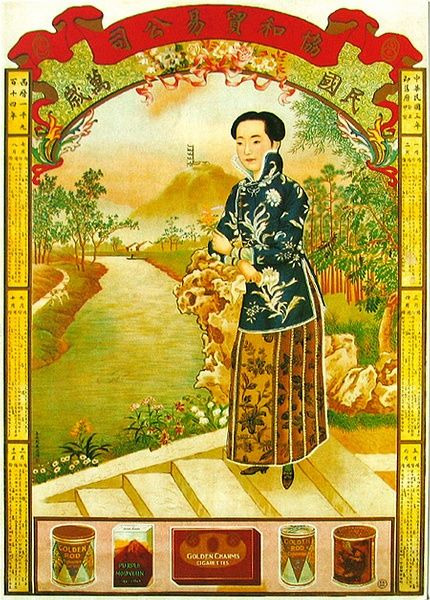
Source here
Calendar painting from 1914. This collar has a rectangular edge and is trimmed with fur.

Source here
Calendar painting from 1915-1916. This collar has a rounded edge and wide binding.
However, this ultra tall collar wasn’t everybody’s cup of tea and normal height collars existed as well, especially in the beginning and end of the decade. A new invention of this era was this tall collar with slightly rounded edges closed by two to three pankou----in some extreme cases four. I believe they were stiffened, but even if they were not, the use of wide, heavyweight binding could give it shape and rigidity. This style probably grew out of collar styles 2 and 3 from 19th century Han women’s collars, but it is going to become very iconic and distinct later in the 30s so let’s label it collar style 8. All Han women’s standing collars before the 1970s were extremely fitted, i.e. they completely hug the wearer’s neck and could sometimes be restrictive to neck movement. The loose fitted collars often seen on modern mass produced cheongsam is not historically accurate.
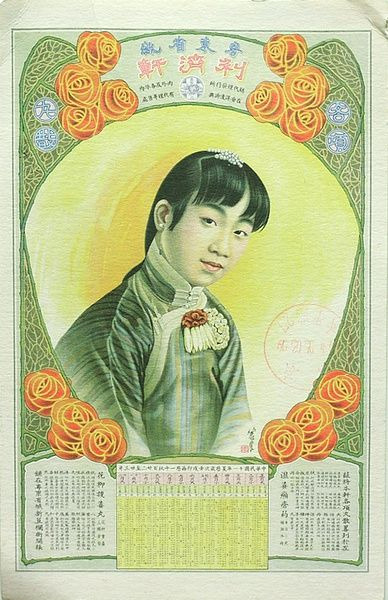
Source here
Calendar painting from 1911 showing collar style 8. It had three pankou, wide double row binding and could be closed at the front.
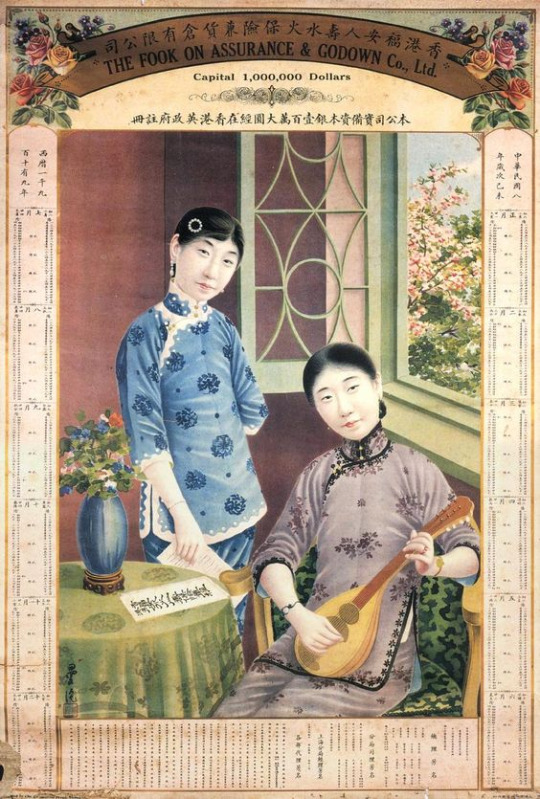
Source here
Calendar painting from 1919 also showing collar style 8. Throughout the 1890s, 1900s, 1910s and early 20s, innovative/Western trims like lace were commonly used instead of plain binding.
Quickly turning our attention to menswear. I’m not a menswear expert so feel free to add info or references. In the 1910s, menswear collars followed a similar development. After looking at more photos from the period, I figured out that in the late 1900s, men’s collars still had rectangular edges and were pretty low. This was also echoed in the formal dress code issued by the republican government in 1912. You can read more about the formal dress code in this article, it’s a great guideline for understanding ceremonial clothing in the republican era.
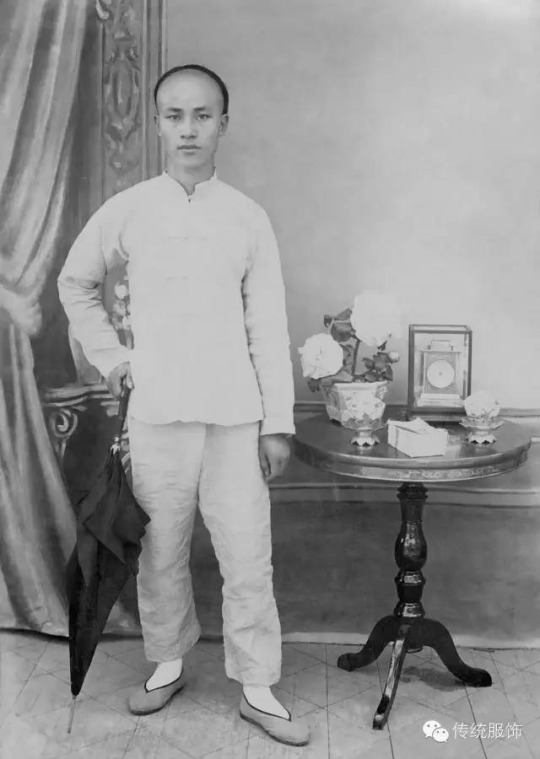
Source here (I’m probably gonna pull most of the menswear photos from the photo album in this article cause they are conveniently dated)
1907 photograph of a certain Mr Ye Jinglv, a legend who preserved his photographs from the 1900s to the 1960s, wearing a 短衫 duanshan short robe and pants.
I have no idea where this collar type came from but the three main suspects are European military uniform collars, Japanese uniform collars (also inspired by European military uniform collars) and Qing Dynasty officials’ collars (now attached to the tunic itself).
As the 1910s progressed, men’s collars gained rounded edges and grew taller just like women’s collars, but they were never so tall to the point that they could not be closed in the front. They were still closed by one plain pankou at the base (men’s pankou has always been plain). This is likely the collar style 6 I identified in part 1 but wasn’t sure about. These collars don’t appear to be stiffened, but rather just constructed of heavyweight fabric similar to the robe itself. Oh and sometimes in photographs you can see men wearing two collars, that is because both the 长衫 changshan, long robe, and 马褂 magua, riding vest, had standing collars in the 1910s, so when both are worn at the same time there will be two collars.
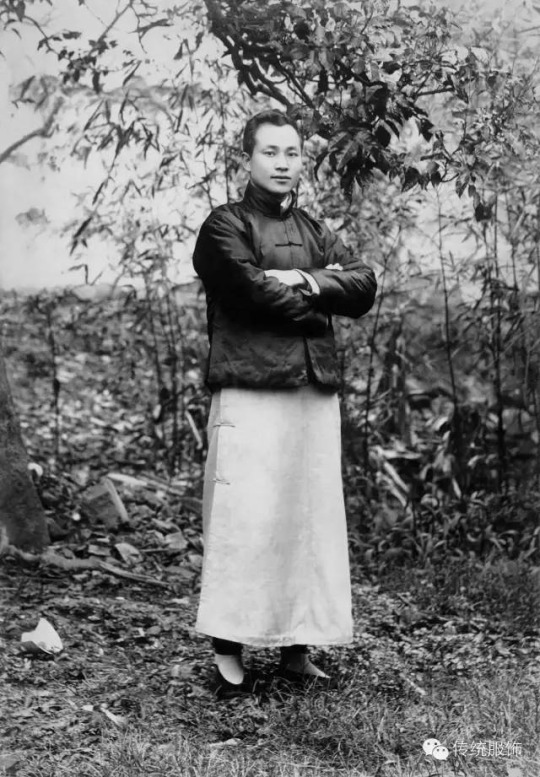
Source here
1916 photograph of Mr Ye Jinglv in a changshan and magua, collar style 6.
1920s
Summary of 1920s Han women’s fashion 1, 2, 3
Going into the 20s collar style 7 went out of fashion completely. The 20s was a wild decade and everything went, but overall collars usually ranged from medium height to tall. There is a wide variety of collar designs in the 20s, women’s dresses with no collar or Western collars like sailor collar, shawl collar or no collar at all etc. all existed, I’ll just list the most common standing collar designs of Chinese origin.
Early 20s collars decreased in height slightly but were still tall standing collars, with rectangular edges, binding and two to three pankous. Let’s call this collar style 9 because it has a will of its own. It’s weirdly reminiscent of collar style 4 from part 1 but the difference is that collar style 4 was unstiffened and had rectangular edges. I don’t think designers in the republican era ever really consciously referenced any historical collar shapes prior to the 19th century... Fashion history was a non-existent academic discipline at that time.

Source here
Calendar painting from 1920 showing collar style 9. It is unstiffened and moderately tall. It has slightly rounded edges, two pankous and a thin row of binding/piping.
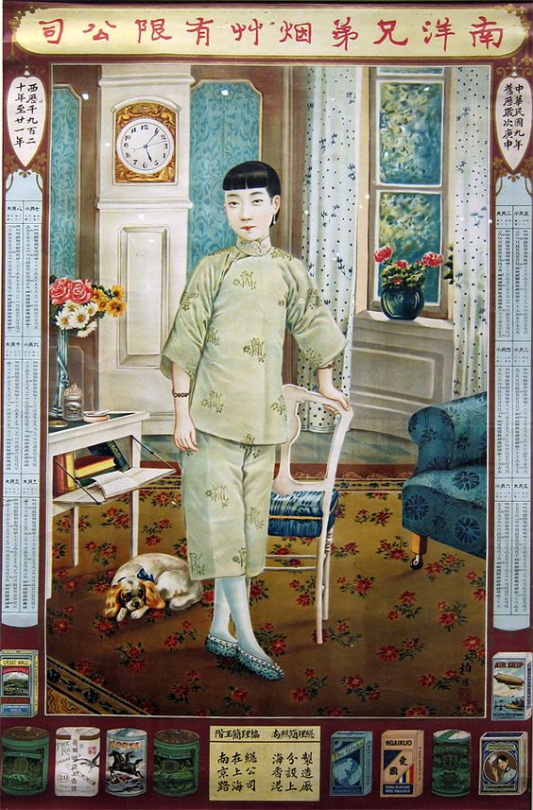
Source here
Calendar painting from 1920-21, showing similar collar style 9 with thin binding and two pankou.
Toward the mid 20s both wide and thin binding could be used and the number of pankou ranged from one to three. I’ve seen multiple times collars with only one pankou at the bottom but still could close completely at the front, which means stiffening was likely used to keep the shape of the collar; I’ll number this collar style 10. The decorations of the mid 20s pursued a tacky aesthetic and were heavily inspired by the 19th century. Alternatively, collars could be decorated with scalloped edges or geometric Western trim. The overall aesthetic was still very 19th century Chinese though. I feel like internal hooks and bars could’ve been used to close these collars, like Western or Japanese military uniform collars, but this is pure speculation.
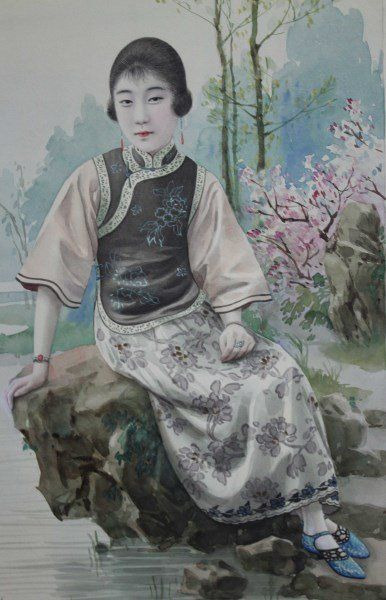
Source here
Watercolor ca. 1926 showing a medium height collar style 10. It closes with only one pankou but holds its shape very well.

Source here or see watermark
Mid 20s artwork showing a similar collar, albeit with thin binding.
Starting from 1928-29 there was this huge trend of using tall, side closing collars. This collar was stiff and structured, tall and closed at the side or back with either pankou or hooks and eyes/bars. It covers the wearer’s neck completely and doesn’t have any openings. This kind of collar was frequently applied to the newly developed cheongsam, which was a one piece dress, to emulate a Western flapper look. The art deco aesthetic was en vogue in the years 1929-31, so there were many cheongsam with innovative closures instead of pankou. I personally really love this look it’s very underrated. This would be collar style 11; it was truly one of a kind since it was never seen again in Chinese fashion history. Rest in Power.
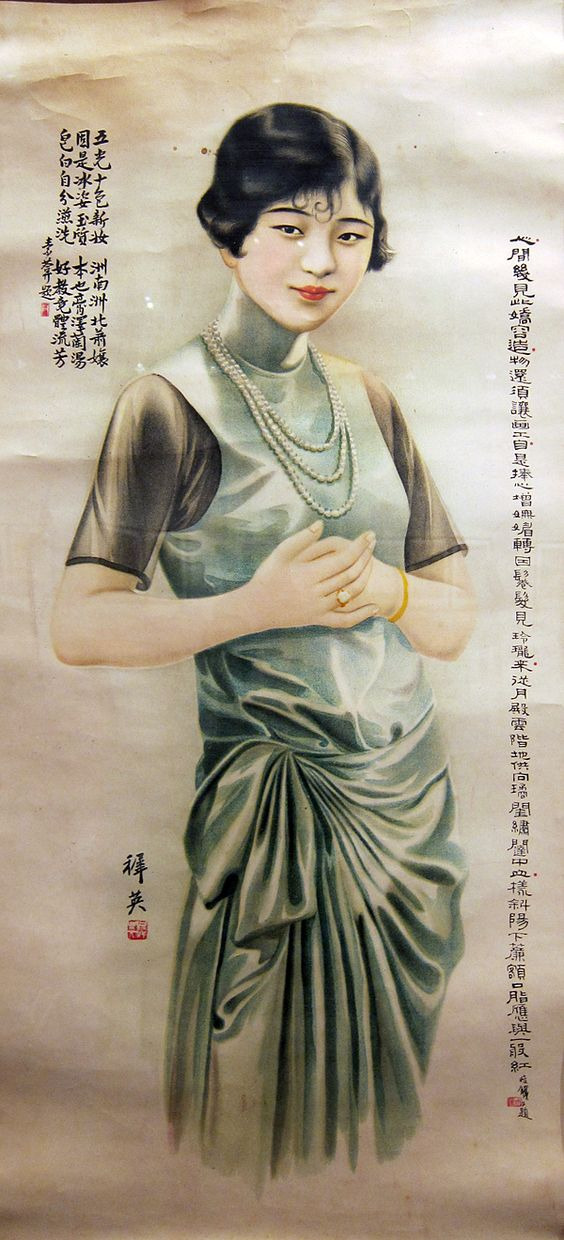
Source here
Painting ca. 1929 showing collar style 11. This is probably closed at the back? Anyway the pankou were not emphasized at this time.

Source here
Kong Sang Hong ad from 1929 showing collar style 11 without visible pankou.
Now menswear again. In the 20s, the tall collar style 6 went out of fashion, following trends in womenswear. The new collar was medium height and still closed by one pankou at the base. It could have either rounded or rectangular edges but rectangular or mostly rectangular edges seem to be more common. I’d say this is similar to collar style 10.
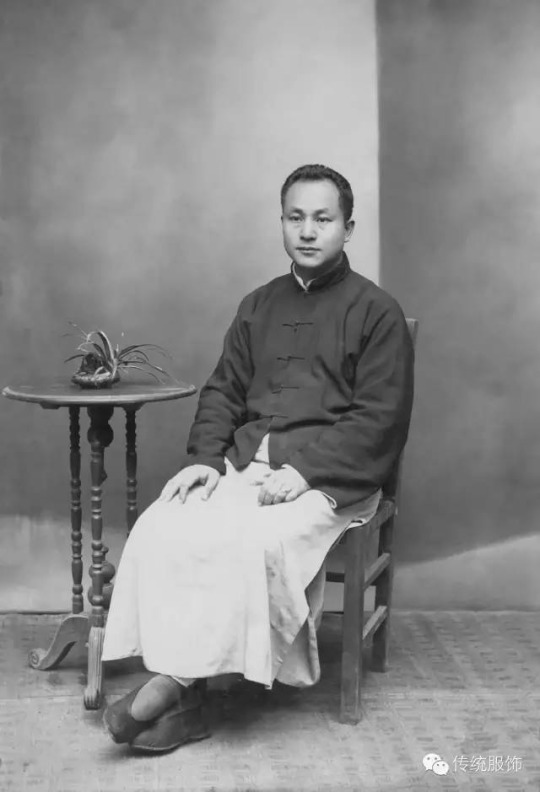
Source here
1925 photograph of Ye Jinglv wearing again changshan and magua.
1930s
Summary of 1930s Han women’s fashion 1, 2
Returning to Han women. Collar 11′s popularity continued to around 1931, when it began to be replaced by a revived version of collar style 8. Collar style 8 with three buttons dominated the majority of the 30s, and these buttons didn’t necessarily have to be pankou; any kind of decorative loop button, clasp or frog closure could be used. 30s collars emphasized the roundness of the buttons, so beads or pearls were commonly used as buttons.
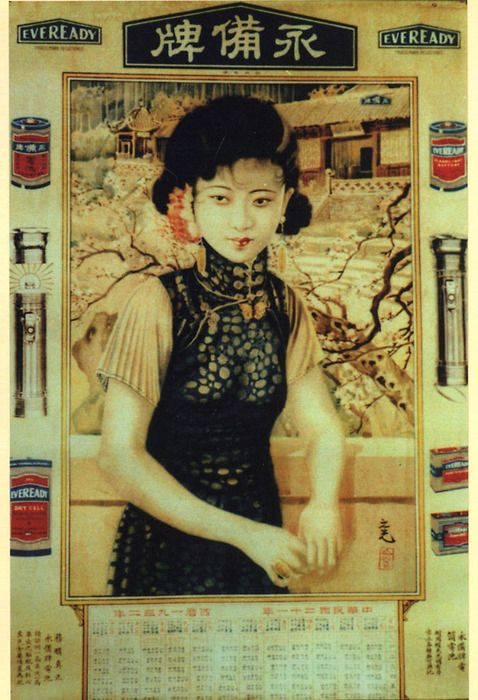
Source here
Calendar painting from 1932 showing collar style 8.
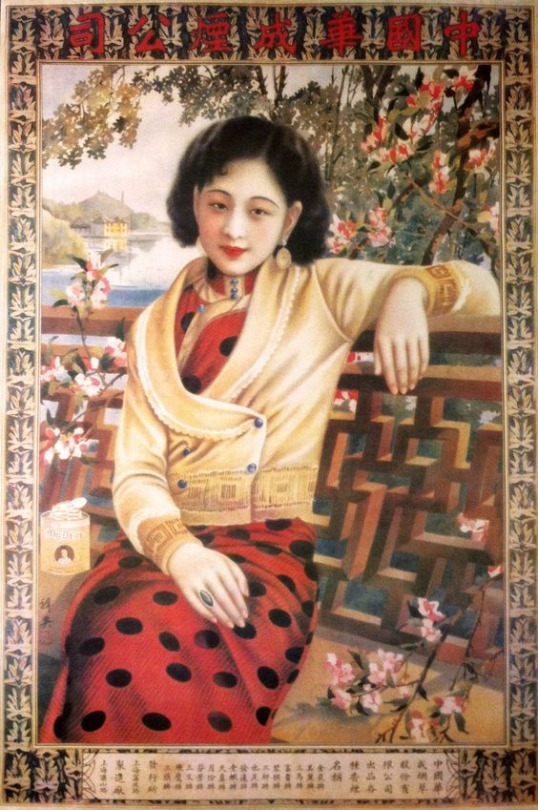
Source here
Mid 30s advertisement showing collar style 8 with bead buttons matching those on the cardigan.

Source here
1932 cover of The Young Companion showing collar style 8 with pearl/bead buttons. Oh collars on a transparent cheongsam would usually be opaque because the interlining/stiffening needs to be hidden.
Men’s collars of the 30s decreased in height again, this time becoming really quite short. Round and rectangular edges coexisted but round edges were still more common. Still closed by one pankou. Not many changes otherwise (gosh, menswear always changes at a glacial pace, y’all men need to step up your game). This foreshadows 40s Han women’s collars so let’s label this collar style 12. Men’s changshan and magua collars stayed this way well into the 40s and 50s.
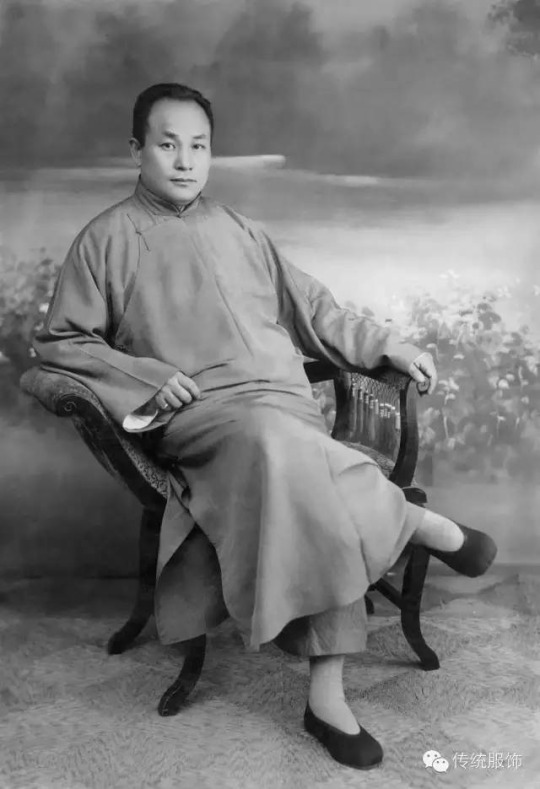
Source here
1935 photograph of Ye Jinglv in changshan with collar style 12.
In the late 30s/early 40s collars dropped in height significantly, regressing to collar styles 9 or 10. It was usually closed with one or two pankou (because there was only enough space for two maximum).

Source here
Late 30s/early 40s artwork depicting the revived collar style 10.
1940s
Summary of 1940s fashion here
As the 40s progressed collars became even shorter, eventually so short that only one pankou could be attached. This developed from collar style 9 but since it was so low and so distinct to the 40s I’d say this is also collar style 12. It may appear similar to collar style 3 from the 19th century but it has rounded edges and is also stiffened and slightly taller.

Source here
Early to mid 40s artwork showing collar style 12.
19th century trims became fashionable again in the early 40s, especially collars with multiple rows of binding/piping. However because of scarcity of materials during the war, that style was only ever seen on actresses and celebrities; cheongsam collars for the average woman were plain.
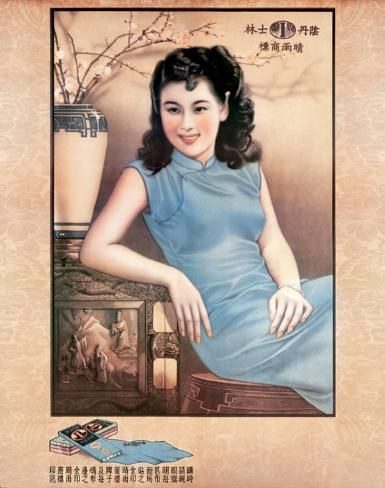
Source here
40s Indanthren fabric ad, showing low collar style 12.
In summary:
Collar style 7: cursed belle époque (ca. 1890-1918) women’s collars that touched the wearer’s face. Extremely tall, stiffened, both rounded and rectangular edges existed. Closed by one pankou at the bottom but sometimes had more pankou for ornamental purposes. Worn by Han women and the plain version for men.
Collar style 8: first appeared in the 1910s, popular in the late 10s and throughout the 30s. As tall as possible without restricting the wearer’s neck movements, stiffened, rounded edges. Closed by two to three pankou. Decorated with wide binding or Western trims like lace in the 10s, multiple rows of binding in the 30s. Worn by Han women.
Collar style 9: developed from collar style 8, popular in the early 20s and late 30s/early 40s. Slightly shorter (medium height), stiffened, rounded edges. Closed by two pankou. Thin binding. Worn by Han women.
Collar style 10: developed from collar style 9, popular in the mid 20s and late 30s/early 40s. Slightly shorter (medium to low height), stiffened, rounded edges. Closed by one pankou at the base. Both wide and thin binding. Worn by Han women and a similar version by men.
Collar style 11: distinctly Western collar, popular 1929-1931. As tall as possible without restricting the wearer’s neck movements, stiffened, rectangular edges. Closed at the side or back with pankou or hooks and eyes. Often plain or of the same fabric as the dress. Worn by Han women.
Collar style 12: developed from collar style 10, popular throughout the 40s. Very short, stiffened, rounded edges. Closed by one pankou at the base. Commonly had thin binding. Worn by Han women and men.
Phew, I thought this was gonna be a short and simple post but it ended up taking way more of my time than I wanted it to. I’m gonna do one last post on the 50s and 60s and maybe address the state of Chinese standing collars nowadays, hopefully that will be actually simple to make lol.
305 notes
·
View notes
Text
Fem Nico Headcanons for @heyimboredtalktome Hope you enjoy these mom!
He wears flowy skirts that twirl prettily and make Will cry of happiness
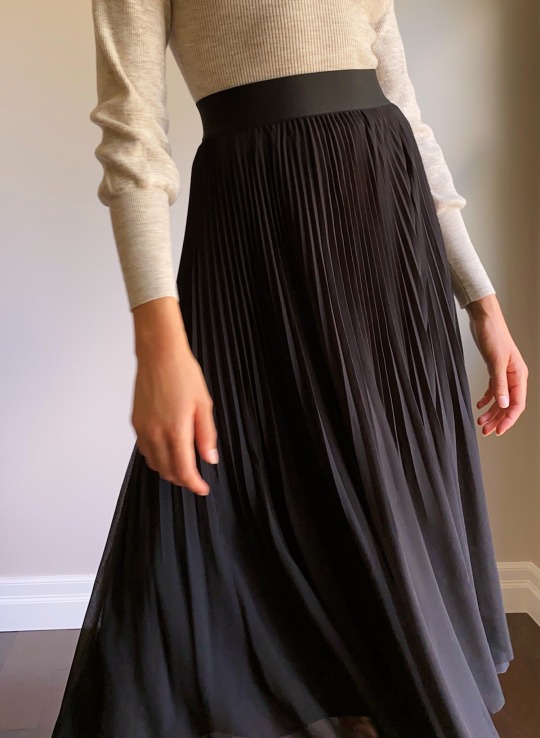
He uses dresses and makeup to enhance his Addams Family Vibes. His goal is for someone to mistake him for Mortitia or Wednesday
He has skeleton hand hair clips
And braids! He loves braids. Waterfall braids, dutch braids, french braids, braided braids, everything
He usually has a pencil or paintbrush stuck in his hair ngl
He has a makeup account where he does goth looks and SFX. he turned Will into Darth Maul on his birthday and omg it was amazing
When he wears shoes, high heels, high heeled thigh high boots, those cute clunky sneakers(see image below), or combat boots boots. Usually just barefoot with vintage goth dresses tho

Has 100% worn a Victorian era dress with heels and a sword as he walked through the Strawberry fields at camp because aesthetic

Pink and blue streaks in his hair! He lost a bet and Loved it so he sticks with it (literally the most colourful thing about him)
Will makes him both flower crowns so when he’s not wearing a tiara or crown he’s got a head full of flowers. They’re always aesthetic and gothish

Beautifully painted nails at all times. His hands are always different colours/patterns
He’s like a magpie and loves shiny things, so he always has different rings and earrings and necklaces and bracelets that Leo helped him make out of shiny rocks and stuff that he found on the sidewalk or at flea markets
He has ribbons tied into his hair all the time!

He has cute little belts to tie at his waist with a-line dresses! There are gold, silver, black, and olive green belts in his closet
He figure skates and has cute little outfits (see Tammie’s post here)
He has cute little bat bags and stuff

Y’know those skinny jeans that are ripped all the way down the legs? He wears those all the time
He shaves his legs and pits too, cause when he exfoliates afterwards his skin is s o f t
He has a number of oversized fluffy hoodies in the full colour spectrum of white to grey to black! They’re so fluffy and warm and Nico loves them
OVERALLS! He never wore them when he was little, but he loves them! Black and grey overalls over sheer shirts and fluffy hoodies are his favourite

About half of his clothes are splattered with paint ngl
(Not fem Nico but Artist Nico can be fem too, right? He usually has charcoal dust smeared across his face and ink stains on his fingers)
Lashes King! He naturally has long and voluminous lashes but with mascara and occasionally false lashes? Stunning
He’s usually got a smokey eye and tons of eyeliner (occasionally smudged for the aesthetic)
He’s very flexible and loves gymnastics. He loves the bars, and can do a reverse giant (really cool thing tho)
He has so many sheer shirts and fishnet shirts
He 100% has a cloak with red swirls at the bottom that he wears over Victorian dresses and skirts
Black lace gloves ALL THE TIME
And he’s got one of those 20’s lady cigarette holder things for the aesthetic of it

He’s got a 40’s movie star hat with the veil (like his mother wore) and he wears pearls cause he’s a classy bitch
Corsets? Hells yes mf. He wears corsets all the time over white flowy shirts cause he feels like a pirate—
Dyed half his hair white for a year because Melanie Martinez is amazing
Pentagram necklaces
He, Thalia, Piper and Reyna trade clothes cause they all have the same general style of ‘comfortable and ready to kick ass’
Has worn knee high socks and he will again
He definitely wears monochrome floral blouses and skirts and dresses
Capris! They are the shortest his pants will ever get. His skirts get to just below his knees and that’s as high up cause he’s a classy bitch and people don’t need to see his legs (not me projecting at all here... cough cough)
No matter what Nico you have (fem, androgynous, masc, whatever) he’s a clothing thief. He steals hoodies and jackets and t-shirts from EVERYONE and they’ve all learned to live with it. Hopdie thief, tshirt thief, boot thief, accessories thief
Eyeliner with cat eyes and the ones pointing down in the inner corner of his eyes
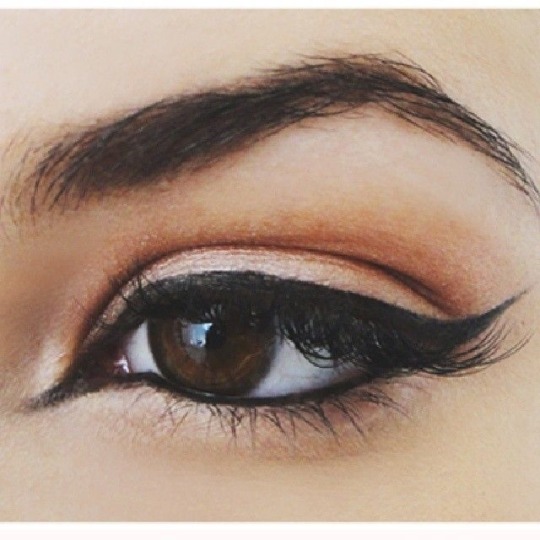
Constantly dripping in jewels to add to the rich cryptic goth vibe he’s got going for him
Basically he channels his inner Mortitia Addams and his inner Janice Ians
Literally hasn’t cut his hair since the military school. It’s down to his waist at this point (isn’t this canon?)
Victory Curls?? HELLS YES
HATS. Big hats, wide brims, cowboy hats, veiled 1930’s hats, beanies. ALL THE HATS
Lots of photos but I hope you enjoy this!
#pjo#hoo#nico di angelo#og post#solangelo#will solace#leo valdez#percy jackson#reyna avilla ramirez arellano#piper mclean#jason grace#frank zhang#hazel lavesque#annabeth chase#toa#thalia grace
107 notes
·
View notes
Photo




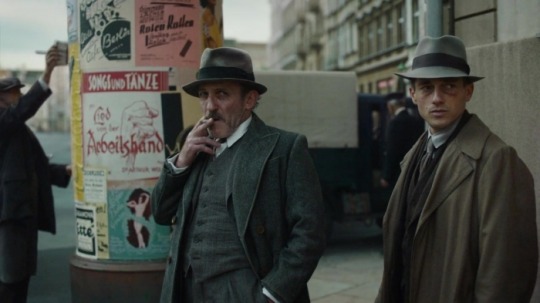
What would you say to a Raymond Chandler-style murder mystery set in 1920s Germany that stars Volker Bruch (a subtle genetic blend of a Young Dennis Hopper and Montgomery Clift) as a PTSD-addled cop, and cute little Lisa Fries as a Weimar-era Nancy Drew? And done on a budget that would embarrass all of Hollywood combined, and crafted with attention to absurd, gorgeous detail that makes Wes Anderson seem carefree.
Hold that notion for a moment.
Babylon Berlin’s noir-infused narrative crawls alongside Germany’s rise to power, which we’ve seen in various productions dozens of times. But rather than stern drama, it’s instead a massive-scale fantasia (the most expensive television production in history) that employs the tropes and features of musicals, surrealism, police procedural, occult mystery, and cliffhanger serials.
Whole episodes seem at times solely devoted to offering brief devotions on the topics of architecture, psychoanalysis, fanaticism, Jugendstil Art Deco, surrealism, or cinema itself. But it’s all done as a delirious (if grim) visual tour, as opposed to a lecture.
I’m not doing the series justice here. Bear in mind that this is a Tom Tykwer project, and it revisits the imaginative, perverse energy of his Run Lola Run and Winter Sleepers work. It gets weirder and broader than all that, by far.
The aesthetic and vibe bring to mind Werner Herzog re-doing the entire “Avengers” British television series of the 1960s as a tribute to Fritz Lang and Neitzsche, or Paul Thomas Anderson reimagining Cabaret as one big episode of “Law & Order.”
It should be seen on a huge HD screen. Just wait until you get a load of the Hermann Platz and Rosenthaler Platz U-Bahn stations, or the Rotes Rathaus city hall on Alexanderplatz. It’s almost like the very sets and structures are characters in this bizarre, heartbreaking story.
Thanks to this series, I’ve had Roxy Music’s “Dance Away” in my head for the past few weeks. No, not the version we all grew up with. I mean the jazz age, klezmer-esque, Kurt Weill-ish version that—with a kind of reverse hauntology—woozily snakes its way through this mesmerizing, almost indescribable tale.
That song is about escaping the heartache of betrayal by getting lost in a pleasant diversion, to the point of obsession. That’s how romance and dating turn out sometimes. Babylon Berlin is about escaping betrayal and heartache because, well, that’s how history and culture turn out sometimes.
In 1920s Berlin, the dancing, along with numerous other diversions that are as perverse, frenetic, dark, and addictive as they want to be, take place in clubs and bars and brothels. Other folks are dancing in the streets, so to speak, in brutal clashes between numerous, barely distinguishable factions of Communists, Social Democrats, and the Berliner Polizist cops. There’s also a group of Trotskyites who can’t catch a break, and countless dual loyalties among Right and Left wings complicating the internecine fights that plague each political group. (Yes, the series does call for a Weimar politics flow chart at times.)
Most intriguing is that there’s hardly a Nazi to be found in the mix, unless you count the occasional dust-up with a few dozen Sturmabteilung bullies (those clumsy lads in sad, military-surplus brown shirts and little red arm bands).
There does seem to be a larger, more organized group waiting in the wings. Bunch of resentful holdovers from the First World War. Old, humorless guys in quite striking forest-green felduniform. Sure, it’s an army, but everyone in Germany in 1928 knows there aren’t going to be any more wars; that’s verrückt talk.
Speaking of crazy, the series has the main character’s mental illness, in the form of post-traumatic stress, function as a metaphor for the Weimar zeitgeist. It might seem like a facile reduction, especially if it were done in service to the notion that the cure is worse than the illness. But something else happens.
The close study of multiple characters in this series suggests that history may not always be guided by x-number of people getting swept up by something larger than themselves. Or by a mad leader.
Yes, a lot of folks march, shout, and fight in unison. But in this realm, major social changes are catalyzed by discrete (and often discreet), traumatic, life-altering personal histories that, solely by accident of geographical proximity, coalesce into what we would call a movement or a cause.
The world did witness the worst possible manifestations of “the madness of crowds” with what followed in Germany during the 1930s. But a deeper examination of what’s known as “the human experience” might reveal that each German was crazy alone before all of them were crazy together.
37 notes
·
View notes
Text
Top Five Harley-Davidson Sportsters, Part One: Ironheads
Harley-Davidson has just rebooted one of the world’s longest-running model lines, with the launch of the new Sportster S. But remarkably, it’s only the third major engine update in the Sportster’s 60-plus years on this earth.
Before the new Revolution Max-powered Sportster S came, we had the Evolution motor that debuted in 1986. And before that, the iconic Ironhead. But throughout each era, the Sportster has always been a mainstay of the custom scene.
To celebrate, we’ve rounded up our ten favorite Sportster builds, divided by their motors. This week, we’re featuring five top-shelf Ironheads from some of the world’s best custom builders—including illustrious names like Max Hazan [above] and Hideya Togashi [below].
Next week, it’s the Evo’s turn.
Hide Motorcycle There’s a long history of Japan’s love for Americana, and the humble Sportster is no exception. Case in point: this Ironhead Sportster by Hideya Togashi of Hide Motorcycle (that’s ‘Hee-day’). It was one of the stars of 2018’s Mooneyes show—a show that Togashi-san is a regular fixture at.
The bike’s built around an original but refurbished 1966 XLCH motor, complete with a Linkert DC-7 carb. But the rest of it is mostly is custom, and it was built without any specific style or theme in mind. “As always, I cherish the balance, and maximize the beauty,” says Hideya.
The motor sits in a scratch-built nickel-plated hardtail frame, with the OEM frame number plate grafted on. Hideya kept the original steering head, triples and forks, but added custom sleeves. The Harley rolls on 21F/18R wheels with drum brakes.
Hideya fabricated the aluminum headlight nacelle and fuel tank, and built the oil tank. The rear fender’s been scalped from a vintage Harley FX Super Glide, then modified to suit. Swept back bars and a pair of beautifully-bent nickel-plated exhausts add to the vintage vibe.
The paint’s extra classy too—a 1930s Harley scheme laid down by Skop Paint Works. Hide’s Ironhead blends vintage speedway and flat track styles together to create a minimalistic and impossibly cool machine. The perfect use of an Ironhead motor. [More]
Hot Chop Speed Shop Here’s another bike that stopped visitors to the 2018 Mooneyes event dead in their tracks: a twin-engined Harley drag bike by Kentaro Nakano at Hot Chop Speed Shop in Kyoto. Using two Sportster XLCH engines, Nakano-san built the monster as a tribute to the drag racers of the 70s.
Unsurprisingly, it picked up two awards at the show—from the top Japanese mags, Hot Bike and Vibes.
‘Double Trouble’ uses a 1969 Ironhead in front, with an older engine at the rear. Both run with S&S Super B carbs, fitted with custom velocity stacks. Kentaro’s friend Kazuhiro Takahashi of Sakai Boring helped rebuild the engines.
The two V-twins are linked by connecting plates, and their output shafts are connected to two separate primaries. The transmission’s a four-speed from a 1980s Big Twin and Kentaro has set the timing of the two motors so that they go ‘potato potato’ at idle, but scream at high revs.
The whole arrangement is housed in a custom hardtail frame, fabricated from steel tubing. There’s a set of early 70s Ducati Imola forks up front, with 18” rims at both ends wrapped in M&H drag slicks. Kentaro installed a pair of Airheart brakes up front, with a Wilwood brake out back.
All of the bodywork was fabricated in aluminum, from scratch. Fuel sits in the cylindrical reservoir up front, with oil held in the seat ‘cowl.’ Custom upholstery from Atelier Cherry adds to the period-correct look.
Double Trouble’s finished off with a narrow set of custom drag bars, with a 1970s H-D tacho out front. The bodywork’s been left raw, with tidy Hot Chop Speed Shop decals on the tank. Buttoned up, it’s both elegant and monstrous. [More]
Hazan Motorworks Max Hazan’s work speaks for itself, but what’s remarkable is that the American builder’s had an unmistakable signature from day one. If you don’t believe us, then consider the fact that this Sportster-powered artwork was only his fourth build.
“I start with a motor that I find aesthetically pleasing, put it on the table, and build the bike around it,” Max told us back then. In this case, the motor is exquisite. Max built it up with two 1981 Ironhead front heads, split the rocker covers and added matching Amal carbs.
The frame was built from 7/8” and 1” steel tubes, and also holds the oil and wiring. The front-end’s a work of art on its own; it uses two springs under the fuel tank, and a damper behind the headlight. The only rear suspension is a pair of springs under the seat, with about 1.5” of travel.
Max had a set of 1920s car tires in his hands, so he built the bike up with a 30” wheel out front, and a 31” hoop at the back. They suit the scale of the bike too—which measures eight feet long, but weighs just 300 lbs.
Almost everything was fashioned by hand, using metal that was lying around the workshop, or, in some cases, small salvaged parts. There’s a frosted shot glass as a taillight cover, and a porcelain doorknob on the hand shifter. The handmade tank only holds 1.5 gallons… but Max is under no illusions about his creation having to be ridden far.
Eight years on, this Ironhead still stands as one of our favorite Harleys—nay, customs—and some of Max’s best work. [More]
HardNine Choppers The 1979 Harley-Davidson XLCR is arguably too rare to be customized these days, but the owner of this Sporty has three. So he had no qualms about handing one over to Swiss builder Danny Schneider for a makeover.
Danny, who operates as HardNine Choppers, is an ex-motocrosser who had previously built two Triumph flat trackers, and was itching to give a Harley the same treatment. So he took on the project with the provision that he could turn it into a tracker. Luckily, the client agreed.
Danny’s work went deep—starting with the motor that he bored out from 997 cc to 1,340 cc, with KB Performance pistons. The carb is from the Harley performance specialists, S&S Cycle, and the exhaust is a custom nickel-plated system that exits under the seat. Danny had to relocate the oil tank to accommodate it.
The custom fuel tank echoes the lines of the original XLCR unit, but it’s actually a slimmer, split design (the left side houses the oil). Danny hand-shaped an aluminum tail section too, with slits to help dissipate heat. He made the seat pad himself, too.
Suspension is by way of Showa shocks from an FXR, fitted with Öhlins cartridges, and Bitubo rear shocks. It rolls on 21F/16R spoked wheels, with a Beringer brake set that Danny drove to the French company’s HQ to have made.
This XLCR is a clever mix of classic style and modern parts, tied together with a host of custom touches and a fresh paint job inspired by a mini-bike spotted on the street (true story).
It’s also a great story of perseverance; Danny took a two-year break in the middle of the project to welcome his daughter into the world and battle testicular cancer. Then he crammed two month’s worth of 15-hour days in to finish it in time for the MBE Expo show in Verona, Italy. Much respect. [More]
DP Customs We’ve featured a slew of slammed and hot-rodded Harleys from the now-defunct DP Customs over the years, but this was one of their wildest. Brothers Jarrod and Justin Del Prado built it as a personal project between client jobs, using Justin’s own 1000 cc 1979 Ironhead Sportster as a donor.
DP Customs went all-out, starting with a turbo that had been sitting in the shop waiting for the right project.
The motor was rebuilt with forged pistons and new valves and springs, then the turbo was installed with a custom draw-through setup, and a Mikuni carb. From the custom aluminum intake and exhaust, to the custom oil system that runs into a Mooneyes tank, it’s an impressive setup.
Like three of the other Harleys on this list, this one features a scratch-built hardtail frame. It uses DP Customs’ signature 6” stretch and 4” drop, with a custom 19” wheel up front, and a modified 15” car wheel at the back. The front brake’s a Brembo, and the rear is a custom system with a combination sprocket and rotor.
Up top is a wafer-thin seat, with a traditional peanut tank up front. DP Customs installed clip-ons with Biltwell Inc. grips, and head- and taillights—but there’s no speedo, and no turn signals. The asymmetrical paint job, red frame and gold wheels should clash, but somehow they harmonize, maximizing the Harley’s eye candy appeal.
DP Customs admit the bike wasn’t built with practicality in mind, summing up that “it hauls ass in a straight line, and the brakes work.” [More]
2 notes
·
View notes
Text
In your first blog post of the semester, explore the tug of war in cinema between the “classical” in cinematic storytelling and those who try to subvert it. Drawing upon examples from the films we have studied thus far, define what “classical” cinematic storytelling is and demonstrate how it functioned in an earlier period of film history, as well as its continuing legacy. Where do you see evidence of the “classical” today? Then, consider how filmmakers working in subversive modes challenge the dominance of classicism, either through subtle, indirect means or by full-on assaults. What kinds of classical storytelling approaches do they reject? How do they do that? What changes in form and content defy the classical? The films we’ve seen will help, as will the various sources you’ve been given for study. Use examples from the films we have studied, and draw upon others that you think are relevant.
Cinema is often thought to be the highest form of art, since it combines storytelling, acting, and music all in one glorious attempt to do something that feels simple, but as we find in exploring the history of film, not so much: the art of telling a story. There are many different ways to approach conveying information in a visual manner, and although the direct method might seem to be the easiest, we find that directors can get away with telling their story in the most imaginative ways possible. From the use of flashbacks, forwards and sometimes even sideways, the viewer is taken on a journey through which they are given the clues needed to piece the entire story together on their own. Directors use these various methods of storytelling often to drive home a point, possibly about how the main protagonist sees the world, or how memories are often skewed through the lenses of either emotion or possible mental illness. Telling a story on screen involves a lot of elements that were cemented as ‘classical’ during the early days of Hollywood, and many directors still utilize these storytelling techniques to this day. Others have forged their own path in defying the classical model of film, whether by altering how the progression of the story is conveyed to the viewers, or simply casting away the norms all together.
As Hollywood began to come into its own in the early 1900′s, many of the silent films that were made followed a recipe for getting its message across to the audience watching the screen. It all started off with Alice Ida Antoinette Guy-Blaché, credited with creating the first directed narrative. Up until that point, most movies that were being made were what we would call by today’s standards ‘b-roll footage’. Images of trains coming into a station, workers leaving factories for the day, and horses running were what was most often seen in early day Nickelodeon’s. Alice was the first to use a three stage story arc when she directed her first short film Suspense. Illustrating the rising action with the mother seeing the robber in the alley below her bedroom window, the climax of the husband bringing the police home with him in time to save his wife and child, and the resolution when the family is safely reunited, and the would-be robber is taken away by the policeman. Using film to not only illustrate a story but take the audience on a journey that tugs at their emotions and leaves them sitting on the edge of their seat was not something that had been done before.

Alice paved the foundation for classical storytelling in early cinema, which was firmly linear for several decades once the Motion Picture Production Code began being firmly enforced by the Catholic Church. Since villainy was to be punished and goodness was to be rewarded in the rules, many of the films that came out between 1934 and 1965 followed the same formula. The man ended up with the woman he was in love with, and they were able to get through whatever troubles sprung up in their way throughout the movie.
We see this in Ninotchka, where a Soviet agent is tempted by the love of a Frenchman named Leon and driven to betray the Communist regime of her country in order to pursue it. Nothing can come between them, not even when she returns to Russia and Leon is barred from visiting her. Even when his romantic letters to her are censored by the Communists, the hope in the story is not completely lost.
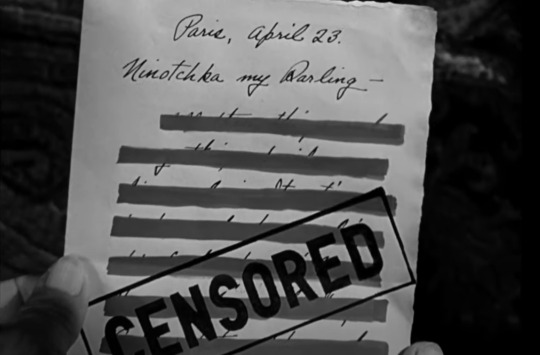
Through all obstacles, Ninotchka and Leon are happily in each other’s arms by the end of the movie. You would think that the Communist regime of 1930’s Russia would easily get in the way of two lovers, but in the glittering bauble of Hollywood, there was seemingly nothing that could prevent the linear storytelling model from rewarding the deeds of the good-doers. Not even a strong-willed, stony Communist woman can ignore the temptation of the love of a man, or the freedom that would come with fleeing her home land. Betraying their home country in the name of love isn’t something many people have to struggle with. Yet we see Ninotchka’s transformation unfold on screen in an almost eerie fashion, under Leon’s influence. At the same time, she doesn’t lose the core of who she is even after falling in love. We see this when she gets quite drunk while out with Leon, and she’s caught promoting Marxist ideals inside the women’s bathroom. At the end of the day, Leon still loves Ninotchka for who she is, Communist and all.
However, some modern films still manage to follow a linear manner of storytelling, even if they are groundbreaking via other means. Take Donnie Darko for instance. Filled with strange imagery that represents Donnie’s visions of how to save the tangent universe from certain destruction, it can feel like a film that displaces the viewer. However, if you have watched it a few times, you can see that the strange, obscure events in the story are still told in the order as they happen. From the night that Frank appears to Donnie and warns him of the world’s impending doom that is to come in twenty-eight days, a countdown begins from that point onward. Even when Donnie is experiencing visions of his school flooded with water, or being egged on by Frank to burn down the house of a local celebrity, we see each day pass by in order until the film’s ending. Images of water and fire are placed against Donnie’s relatively normal, everyday life as a high school boy in a stark, brilliantly vivid contrast.

While Richard Kelly could have chosen to present the film’s events out of order or utilize flash backs and forwards to communicate his vision, his unique and bizarre story was easier to understand since it was told linearly. Kelly still manages to subvert the norm by creating his own science behind what was happening to Donnie, between the tangent universe, living receiver and the manipulated dead and living. Kelly also did not feel the need to show the audience every last little detail of Donnie’s abilities and experiences, feeling that ‘less was more’ in his interview in The Donnie Darko Book. Rather than showing Donnie levitating off of the ground and swinging the axe into the bronze statue of the school’s mascot, Kelly instead cuts to the scene where the disfigured piece of art is discovered by both the police and the principal.

Choosing to let the audience use their own imaginations to fill in the blanks allows the viewer to come up with their own creative ideas as to how events unfold, instead of being spoon fed them shot by shot. A cult classic, Donnie Darko still comes to mind all these years later whenever the topic of films that challenge the classical model through indirect and still wildly creative means.
Then there are directors which completely subvert the linear story model, turning it on its head and taking the audience through an unexpected, wild ride where they are never quite sure if they can trust what they are seeing on screen. Robert Eggers’ newest film The Lighthouse is a story that is difficult to grasp on the first viewing. Even in just aesthetic terms, Eggers goes against the norm in choosing the 4x3 aspect ratio for his movie, instead of the traditional widescreen. It brings us closer to the actors and their rapid descent into madness, giving off a sense of claustrophobia as the dread slowly builds on screen. The movie is shot in black and white instead of contemporary color film, which leads to our eyes having fewer things to be distracted by as we watch. It also adds to the otherworldly, nightmarish atmosphere of the movie, and gives the director more opportunities to use the lighting on set to convey the deeper messages that are found in The Lighthouse.
Eggers has a way of giving the viewer a creeping sense of foreboding without showing anything scary at all. The opening shot of The Lighthouse begins with a large ship cutting through dark and stormy waters, and then we see our two main characters shot from behind with the lighthouse towering above their heads, accompanied by tense music. There’s something to be feared in these beginning moments, even if the viewer can’t quite put their finger on just what it is yet.

The audience is not sure if the main protagonist, Winslow, is a reliable character or not. There comes a point in the movie where everything we are led to believe up to that point is turned onto its head, and from that moment forward the viewer can not tell if Winslow is of sound mind or not.
The night before their shift is supposed to end and the ferry will come to take them away from the lighthouse and the island, Winslow finally breaks his sobriety and he gets quite drunk with Wake. During what we think is the next day (any attention paid to how much time has passed feeling scrambled by this point), Wake informs Winslow that the rot has gotten to their salted fish. Winslow replies that they had only missed the ferry by a day, and there is no need to ration their food. Wake replies that it had been weeks since they had missed the ferry that was supposed to take them home, not a single day. Wake also says that he had been telling Winslow to ration their food for the past few weeks, to which Winslow does not believe him. Wake comments that he does not want to be stuck at his post with a lunatic, and bids Winslow to go with him to dig up their extra rations, which turn out to be comprised of nothing but more alcohol. Wake makes a few slip-ups of his own in recounting his sailor days with Winslow, having two different versions of how he lost his leg, or whether or not he had been married and had a family. Between Wake’s lying and Winslow’s seemingly unstable mental state, there is no reliable narrator to trust throughout the film.
From then onward, the film spirals into such madness that the viewer can only hope to retain their wits enough to follow what is unfolding on the screen and attempt to piece together what is real and what is not in their own mind. We no longer have any baseline for reality to cling to at this point, between the excessive drinking on screen, and the characters’ untrustworthy narrations. Eggers gives us only the briefest, pin-prick sized moments of normalcy, such as Wake and Winslow catching lobsters for their dinner, or Winslow attending to his various duties on the small outcrop of land that the lighthouse sits on. Even then it is difficult to pay close attention to these tiny seconds of peace after having been put through a dizzying whirlwind of stimulus only seconds prior, with visions of sirens washed up on the beach, or tentacles belonging to some great, terrible beast sliding across the top floor of the lighthouse.


The linear model of storytelling that was cemented in early Hollywood is classical for good reason. The early directors and screenwriters of that era paved the foundation that modern day films still utilize nearly a hundred years later, setting a standard that directors can either utilize, or subvert entirely. It is safe to say that there is no limit on creativity and ingenuity, no matter how the director may choose to tell their story on screen. Whether they follow the classical model, subvert it entirely or land in some sort of middle ground, we as the audience are given plenty of artistic content to work with and ponder about regardless of what they choose.
6 notes
·
View notes
Text
Elizabeth Catlett

Elizabeth Catlett (April 15, 1915 – April 2, 2012) was an American and Mexican graphic artist and sculptor best known for her depictions of the African-American experience in the 20th century, which often focused on the female experience. She was born and raised in Washington, D.C. to parents working in education, and was the grandchild of freed slaves. It was difficult for a black woman in this time to pursue a career as a working artist. Catlett devoted much of her career to teaching. However, a fellowship awarded to her in 1946 allowed her to travel to Mexico City, where she worked with the Taller de Gráfica Popular for twenty years and became head of the sculpture department for the Escuela Nacional de Artes Plásticas. In the 1950s, her main means of artistic expression shifted from print to sculpture, though she never gave up the former.
Her work is a mixture of abstract and figurative in the Modernist tradition, with influence from African and Mexican art traditions. According to the artist, the main purpose of her work is to convey social messages rather than pure aesthetics. Her work is heavily studied by art students looking to depict race, gender and class issues. During her lifetime, Catlett received many awards and recognitions, including membership in the Salón de la Plástica Mexicana, the Art Institute of Chicago Legends and Legacy Award, honorary doctorates from Pace University and Carnegie Mellon, and the International Sculpture Center's Lifetime Achievement Award in contemporary sculpture.
Early life
Catlett was born and raised in Washington, D.C. Both her mother and father were the children of freed slaves, and her grandmother told her stories about the capture of their people in Africa and the hardships of plantation life. Catlett was the youngest of three children. Both of her parents worked in education; her mother was a truant officer and her father taught at Tuskegee University, the then D.C. public school system. Her father died before she was born, leaving her mother to hold several jobs to support the household.
Catlett's interest in art began early. As a child she became fascinated by a wood carving of a bird that her father made. In high school, she studied art with a descendant of Frederick Douglass.
Education
Catlett completed her undergraduate studies at Howard University, graduating cum laude, although it was not her first choice. She was also admitted into the Carnegie Institute of Technology but was refused admission when the school discovered she was black. However, in 2007, as Cathy Shannon of E&S Gallery was giving a talk to a youth group at the August Wilson Center for African American Culture in Pittsburgh, PA, she recounted Catlett's tie to Pittsburgh because of this injustice. An administrator with Carnegie Mellon University was in the audience and heard the story for the first time. She immediately told the story to the school's president, Jared Leigh Cohon, who was also unaware and deeply appalled that such a thing had happened. In 2008, President Cohon presented Catlett with an honorary Doctorate degree and a one-woman show of her art was presented by E&S Gallery at The Regina Gouger Miller Gallery on the campus of Carnegie Mellon University.
At Howard University, Catlett's professors included artist Lois Mailou Jones and philosopher Alain Locke. She also came to know artists James Herring, James Wells, and future art historian James A. Porter. Her tuition was paid for by her mother's savings and scholarships that the artist earned, and she graduated with honors in 1937. At the time, the idea of a career as an artist was far-fetched for a black woman, so she completed her undergraduate studies with the aim of being a teacher. After graduation, she moved to her mother's hometown of Durham, NC to teach high school.
Catlett became interested in the work of landscape artist Grant Wood, so she entered the graduate program of the University of Iowa where he taught. There, she studied drawing and painting with Wood, as well as sculpture with Harry Edward Stinson. Wood advised her to depict images of what she knew best, so Catlett began sculpting images of African-American women and children. However, despite being accepted to the school, she was not permitted to stay in the dormitories, therefore she rented a room off-campus. One of her roommates was future novelist and poet Margaret Walker. Catlett graduated in 1940, one of three to earn the first masters in fine arts from the university, and the first African-American woman to receive the degree.
After Iowa, Catlett moved to New Orleans to work at Dillard University, spending the summer breaks in Chicago. During her summers, she studied ceramics at the Art Institute of Chicago and lithography at the South Side Community Art Center. In Chicago, she also met her first husband, artist Charles Wilbert White. The couple married in 1941. In 1942, the couple moved to New York, where Catlett taught adult education classes at the George Washington Carver School in Harlem. She also studied lithography at the Art Students League of New York, and received private instruction from Russian sculptor Ossip Zadkine, who urged her to add abstract elements to her figurative work. During her time in New York, she met intellectuals and artists such as Gwendolyn Bennett, W. E. B. Dubois, Ralph Ellison, Langston Hughes, Jacob Lawrence, Aaron Douglas, and Paul Robeson.
In 1946, Catlett received a Rosenwald Fund Fellowship to travel with her husband to Mexico and study. She accepted the grant in part because at the time American art was trending toward the abstract while she was interested in art related to social themes. Shortly after moving to Mexico that same year, Catlett divorced White. In 1947, she entered the Taller de Gráfica Popular, a workshop dedicated to prints promoting leftist social causes and education. There she met printmaker and muralist Francisco Mora, whom she married later that same year. The couple had three children, all of whom developed careers in the arts: Francisco in jazz music, Juan Mora Catlett in filmmaking, and David in the visual arts. The last worked as his mother's assistant, performing the more labor intensive aspects of sculpting when she was no longer able. In 1948, she entered the Escuela Nacional de Pintura, Escultura y Grabado "La Esmeralda" to study wood sculpture with José L. Ruíz and ceramic sculpture with Francisco Zúñiga. During this time in Mexico, she became more serious about her art and more dedicated to the work it demanded. She also met Diego Rivera, Frida Kahlo, and David Alfaro Siqueiros.
In 2006, Kathleen Edwards, the curator of European and American art, visited Catlett in Cuernavaca, Mexico and purchased a group of 27 prints for the University of Iowa Museum of Art (UIMA). Catlett donated this money to the University of Iowa Foundation in order to fund the Elizabeth Catlett Mora Scholarship Fund, which supports African-American and Latino students studying printmaking. Elizabeth Catlett Residence Hall on the University of Iowa campus is named in her honor.
Activism
Catlett worked with the Taller de Gráfica Popular (TGP) from 1946 until 1966. However, because some of the members were also Communist Party members, and because of her own activism regarding a railroad strike in Mexico City had led to an arrest in 1949, Catlett came under surveillance by the United States Embassy. Eventually, she was barred from entering the United States and declared an "undesirable alien." She was unable to return home to visit her ill mother before she died. In 1962, she renounced her American citizenship and became a Mexican citizen.
In 1971, after a letter-writing campaign to the State Department by colleagues and friends, she was issued a special permit to attend an exhibition of her work at the Studio Museum in Harlem.
Later years
After retiring from her teaching position at the Escuela Nacional de Artes Plásticas, Catlett moved to the city of Cuernavaca, Morelos in 1975. In 1983, she and Mora purchased an apartment in Battery Park City, NY. The couple spent part of the year there together from 1983 until Mora's death in 2002. Catlett regained her American citizenship in 2002.
Catlett remained an active artist until her death. The artist died peacefully in her sleep at her studio home in Cuernavaca on April 2, 2012, at the age of 96. She is survived by her 3 sons, 10 grandchildren, and 6 great-grandchildren.
Career
Very early in her career, Catlett accepted a Public Works of Art Project assignment with the federal government for unemployed artists during the 1930s. However, she was fired for lack of initiative, very likely due to immaturity. The experience gave her exposure to the socially-themed work of Diego Rivera and Miguel Covarrubias.
Much of her career was spent teaching, as her original intention was to be an art teacher. After receiving her undergraduate degree, her first teaching position was in the Durham, NC school system. However, she became very dissatisfied with the position because black teachers were paid less. Along with Thurgood Marshall, she participated in an unsuccessful campaign to gain equal pay. After graduate school, she accepted a position at Dillard University in New Orleans in the 1940s. There, she arranged a special trip to the Delgado Museum of Art to see the Picasso exhibit. As the museum was closed to black people at the time, the group went on a day it was closed to the public. She eventually went on to chair the art department at Dillard. Her next teaching position was with the George Washington Carver School, a community alternative school in Harlem, where she taught art and other cultural subjects to workers enrolled in night classes. Her last major teaching position was with the Escuela Nacional de Artes Plásticas at the National Autonomous University of Mexico (UNAM), starting in 1958, where she was the first female professor of sculpture. One year later, she was appointed the head of the sculpture department despite protests that she was a woman and a foreigner. She remained with the school until her retirement in 1975.
When she moved to Mexico, Catlett's first work as an artist was with the Taller de Gráfica Popular (TGP), a famous workshop in Mexico City dedicated to graphic arts promoting leftist political causes, social issues, and education. At the TGP, she and other artists created a series of linoleum cuts featuring prominent black figures, as well as posters, leaflets, illustrations for textbooks, and materials to promote literacy in Mexico. Catlett’s immersion into the TGP was crucial for her appreciation and comprehension of the signification of “mestizaje”, a blending of Indigenous, Spanish and African antecedents in Mexico, which was a parallel reality to the African American experiences. She remained with the workshop for twenty years, leaving in 1966. Her posters of Harriet Tubman, Angela Davis, Malcolm X and other figures were widely distributed.
Although she had an individual exhibition of her work in 1948 in Washington, D.C., her work did not begin to be shown regularly until the 1960s and 1970s, almost entirely in the United States, where it drew interest because of social movements such as the Black Arts Movement and feminism. While many of these exhibitions were collective, Catlett had over fifty individual exhibitions of her work during her lifetime. Other important individual exhibitions include Escuela Nacional de Arte Pláticas of UNAM in 1962, Museo de Arte Moderno in 1970, Los Angeles in 1971, the Studio Museum in Harlem in New York in 1971, Washington, D.C. in 1972, Howard University in 1972, Los Angeles County Museum of Art in 1976, Miller Gallery at Carnegie Mellon University in 2008, and the 2011 individual show at the Bronx Museum. From 1993 to 2009, her work was regularly on display at the June Kelly Gallery.
Catlett's work can be found in major collections such as those of the Museum of Modern Art, Metropolitan Museum of Art, Library of Congress, Minneapolis Institute of Arts, National Museum in Prague, the Toledo Museum of Art, the Clark Atlanta University Art Galleries, the Palacio de Bellas Artes in Mexico, the Instituto Politécnico Nacional, Carnegie Mellon University, the University of Iowa, the June Kelly Gallery and the Schomburg Center for Research in Black Culture in New York.
The Legacy Museum, which opened on April 26, 2018, displays and dramatizes the history of slavery and racism in America, and features artwork by Catlett and others.
Awards and recognition
During Catlett's lifetime she received numerous awards and recognitions. These include First Prize at the 1940 American Negro Exposition in Chicago, induction into the Salón de la Plástica Mexicana in 1956, the Distinguished Alumni Award from the University of Iowa in 1996, a 1998 50-year traveling retrospective of her work sponsored by the Newberger Museum of Art at Purchase College, a NAACP Image Award in 2009, and a joint tribute after her death held by the Salón de la Plástica Mexicana and the Instituto Politécnico Nacional in 2013. Others include an award from the Women's Caucus for Art, the Art Institute of Chicago Legends and Legacy Award, Elizabeth Catlett Week in Berkeley, Elizabeth Catlett Day in Cleveland, honorary citizenship of New Orleans, honorary doctorates from Pace University and Carnegie Mellon, and the International Sculpture Center's Lifetime Achievement Award in contemporary sculpture. The Taller de Gráfica Popular won an international peace prize in part because of her achievements . She received a Candace Award from the National Coalition of 100 Black Women in 1991.
Art historian Melanie Herzog has called Catlett "the foremost African American woman artist of her generation." By the end of her career, her works, especially her sculptures, sold for tens of thousands of dollars.
In 2017, Catlett's alma mater, the University of Iowa, opened a new residence hall that bears her name.
Catlett was the subject of an episode of the BBC Radio 4 series An Alternative History of Art, presented by Naomi Beckwith and broadcast on March 6, 2018.
Artistry
Catlett is recognized primarily for sculpting and print work. Her sculptures are known for being provocative, but her prints are more widely recognized, mostly because of her work with the Taller de Gráfica Popular. Although she never left printmaking, starting in the 1950s, she shifted primarily to sculpture. Her print work consisted mainly of woodcuts and linocuts, while her sculptures were composed of a variety of materials, such as clay, cedar, mahogany, eucalyptus, marble, limestone, onyx, bronze, and Mexican stone (cantera). She often recreated the same piece in several different media. Sculptures ranged in size and scope from small wood figures inches high to others several feet tall to monumental works for public squares and gardens. This latter category includes a 10.5-foot sculpture of Louis Armstrong in New Orleans and a 7.5-foot work depicting Sojourner Truth in Sacramento.
Much of her work is realistic and highly stylized two- or three-dimensional figures, applying the Modernist principles (such as organic abstraction to create a simplified iconography to display human emotions) of Henry Moore, Constantin Brancusi and Ossip Zadkine to popular and easily recognized imagery. Other major influences include African and pre-Hispanic Mexican art traditions. Her works do not explore individual personalities, not even those of historical figures; instead, they convey abstracted and generalized ideas and feelings. Her imagery arises from a scrupulously honest dialogue with herself on her life and perceptions, and between herself and "the other", that is, contemporary society's beliefs and practices of racism, classism and sexism. Many young artists study her work as a model for themes relating to gender, race and class, but she is relatively unknown to the general public.
Her work revolved around themes such as social injustice, the human condition, historical figures, women and the relationship between mother and child. These themes were specifically related to the African-American experience in the 20th century with some influence from Mexican reality. This focus began while she was at the University of Iowa, where she was encouraged to depict what she knew best. Her thesis was the sculpture Mother and Child (1939), which won first prize at the American Negro Exposition in Chicago in 1940.
Her subjects range from sensitive maternal images to confrontational symbols of Black Power, and portraits of Martin Luther King, Jr., Malcolm X, Harriet Tubman, Rosa Parks, and writer Phyllis Wheatley, as she believed that art can play a role in the construction of transnational and ethnic identity. Her best-known works depict black women as strong and maternal. The women are voluptuous, with broad hips and shoulders, in positions of power and confidence, often with torsos thrust forward to show attitude. Faces tend to be mask-like, generally upturned. Mother and Child (1939) shows a young woman with very short hair and features similar to that of a Gabon mask. A late work Bather (2009) has a similar subject flexing her triceps. Her linocut series The Black Woman Speaks, is among the first graphic series in Western art to depict the image of the American black woman as a heroic and complex human being. Her work was influenced by the Harlem Renaissance movement and the Chicago Black Renaissance in the 1940s and reinforced in the 1960s and 1970s with the influence of the Black Power, Black Arts Movement and feminism. With artists like Lois Jones, she helped to create what critic Freida High Tesfagiorgis called an "Afrofemcentrist" analytic.
The Taller de Gráfica Popular pushed her to adapt her work to reach the broadest possible audience, which generally meant balancing abstraction with figurative images. She stated of her time at the TGP, "I learned how you use your art for the service of people, struggling people, to whom only realism is meaningful."
Critic Michasel Brenson noted the "fluid, sensual surfaces" of her sculptures, which he said "seem to welcome not just the embrace of light but also the caress of the viewer's hand." Ken Johnson said that Ms. Catlett "gives wood and stone a melting, almost erotic luminosity." But he also criticized the iconography as "generic and clichéd."
However, Catlett was more concerned in the social messages of her work than in pure aesthetics. "I have always wanted my art to service my people – to reflect us, to relate to us, to stimulate us, to make us aware of our potential." She was a feminist and an activist before these movements took shape, pursuing a career in art despite segregation and the lack of female role models. "I don't think art can change things," Catlett said: "I think writing can do more. But art can prepare people for change, it can be educational and persuasive in people's thinking."
Catlett also acknowledged her artistic contributions as influencing younger black women. She relayed that being a black woman sculptor "before was unthinkable. ... There were very few black women sculptors – maybe five or six – and they all have very tough circumstances to overcome. You can be black, a woman, a sculptor, a print-maker, a teacher, a mother, a grandmother, and keep a house. It takes a lot of doing, but you can do it. All you have to do is decide to do it."
Artist statements
No other field is closed to those who are not white and male as is the visual arts. After I decided to be an artist, the first thing I had to believe was that I, a black woman, could penetrate the art scene, and that, further, I could do so without sacrificing one iota of my blackness or my femaleness or my humanity.
"Art for me must develop from a necessity within my people. It must answer a question, or wake somebody up, or give a shove in the right direction — our liberation."
Selected works
Students Aspire
"For My People" portfolio, published 1992 by Limited Editions Club, New York
"Ralph Ellison Memorial", Manhattan
"Torso", created in 1985, is a carving in mahogany modeled after another of Catlett's pieces, Pensive (b. 1946) a bronze sculpture. The mahogany carving is in the York College, CUNY Fine Art Collection (dimensions: 35' H x 19' W x 16' D). The exaggerated arms and breasts are prominent features of this piece. The crossed arms are broad, with simple geometric shapes and ripples to indicate a shirt with rolled-up sleeves, along with a gentle ridge along the neck. The hands are carved larger than what would be in proportion to the torso. The figure's eyes are painted with a calm, yet steady gaze that signifies confidence. Catlett evokes a strong, working-class black woman similar to her other pieces that she created to portray women's empowerment through expressive poses. Catlett favored materials such as cedar and mahogany because these materials naturally depict brown skin.
Selected collections
Miami-Dade Public Library System, Miami-Dade County, FL
Minneapolis Institute of Art, Minneapolis, MN
Detroit Institute of Arts, Detroit, MI
8 notes
·
View notes
Text
Vintage Parker Vacumatic Star-Clip Fountain Pen Silver

Vintage Parker Vacumatic Fountain Pen
- Rare STAR pocket clip
- Semi-transparent laminated silver pearl striped barrel
- Deluxe double jewel/ twin-tassie with matching silver striped pattern
- Art-deco capband
- Vacumatic speedline filler
Up here is a vintage Parker vacumatic fountain pen, which was manufactured in USA circa 1930s.
The pen is in nice condition.
On the pocket clip there is a "STAR" at the top. This is specially rare which only produced for a few months during 1930s.
The pen illustrates silver pearl striped pattern, and it is amber SEMI-TRANSPARENT, you can see the ink flow inside.
The pen bears an art-deco capband;
The pen also bears deluxe double jewels, with matching silver striped marble pattern.
It is fitted with a Parker 14ct solid gold nib, writing smooth medium line.
A new vacumatic sac has been fitted. The speedline filling system is special and in working order. .
This Parker is a classic elegance and has been produced to the highest standards of craftsmanship, technology, and aesthetics. This would make an excellent gift to treat yourself or someone important. Please check this out at our shop for other Parker vacumatic collections.
The Parker Pen Company was founded in 1888 by George S. Parker, whose mission was to manufacture a better pen. The Parker Pen Company's tradition epitomizes the highest standards of craftsmanship, technology, and aesthetics. From the 1920s to the 1960s, Parker was No.1 in worldwide writing instrument sales. The Parker Duofold is one of the most recognizable and enduring fountain pen designs. Launched in 1921, the pen was a phenomenal success and put the Parker Pen Company squarely into the front rank of fountain pen manufacturers. Duofold remain popular in Europe being produced well into the 60s in varying sizes and colors when it was revived in the 80's once again as Parker's Flagship model.
In 1932, Parker began test marketing the next generation in fountain pens, the Golden Arrow. This radical new pen featured a compact plunger-operated pump filler that nestled at the back end of the barrel, eliminating the space-hungry pressure bar and sac. The Golden Arrow was later renamed as Vacumatic. The Vacumatic went on the market in 1933; and discontinued in 1939, due to the introduction of new Aero-metric filler.
Parker pens were frequently selected to sign important documents such as the World War II armistices, and commemorative editions were sometimes offered.
Read the full article
0 notes
Text
Analyzing the Snicket Aesthetic, Part 1/5: Time Period, Technology, and Medicine
.-There are quite a few fan theories placing the main events of ASOUE in the 80’s or 90’s, which is plausible, if not quite probable, in terms of the technology present in the series and the timing of the real-life publication of the books. On the other hand, I’m a shameless hipster and I live for that retro aesthetic, so I like the ambiguity.
-The post-post-apocalyptic theory is a fun one, but it can be a little limiting—not to mention difficult—to apply too many practical implications to this universe. Realism is all well and good, but it can easily be discarded for the sake of a good yarn or a pointed bit of commentary.
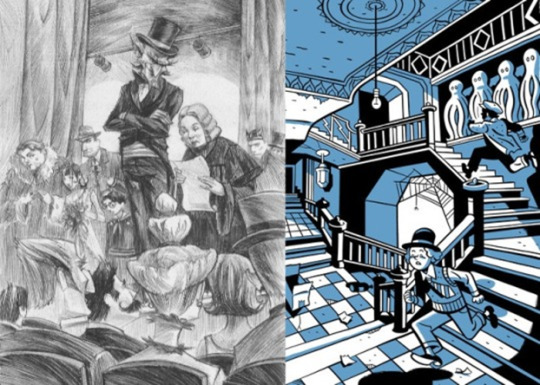
Figure 1: The Illustrations of ASOUE are mostly influenced by the woodblock prints that frequently appeared in Victorian fiction--black and white, hatched shading, realistic perspective—while those of ATWQ vaguely resemble Modernist and/or Cubist art—subtle color, solid shadows, and slightly warped perspective.
(Continued under the cut)
-Anachronisms everywhere, of course. One of the books mentions a blacksmith and a computer repair shop in the same sentence. Events and media from before, during, or (infrequently) after the date range are regularly referenced.
-Personally, I mix and match from a date range of about 1890-1980, for reasons we’ll get into over the course of this analysis, although this is really quite a large range, and even then it’s rather approximate, and can change depending on which version of the story one is referencing, and even from book to book or character to character.
-Time does not pass normally like in the real world. The atmosphere of ASOUE feels a bit older (gothic, vaguely turn of the century) than that of ATWQ (noir, 1930’s-40’s), but the latter is set before the former (see fig. 1). History has been run through a blender set to puree.
TECHNOLOGY
-It’s sort of lowkey steampunk/dieselpunk. Relatively little sci fi tech is floating loose in the world, but given the materials and time, Violet would almost certainly come up with some fun retro-futuristic inventions.
-Violet’s inventions involve mechanical and electrical technology, but seemingly nothing digital. She’s largely indifferent (and in the books, possibly even disdainful) in response to the “advanced computer” at Prufrock Prep, which always struck me as a bit odd. Maybe she distrusts Nero’s vague assertions that it will deter Count Olaf, maybe she prefers a more hands-on approach to inventing, or maybe she has the soul of cranky old lady.

Figure 2: Prufrock’s advanced computer in the Netflix series features cameras, a CRT monitor, and something resembling an oscilloscope.
-Computers exist in this universe, but they don’t seem to do much, and there aren’t very many of them. Smart phones, laptops, and similar devices of the 21st century are almost certainly not around.
-In the books, Prufrock’s computer can display a recognizable image of Count Olaf and is compared to a toad in appearance, meaning it was likely modeled after PCs from the 80s and 90s.
-In the series, it’s even more anachronistic. The monitor looks more or less like what was described in the books, but it also comes fitted with a built in camera, much like a modern webcam, and can recognize faces about as well as most characters (although this really isn’t saying much), implying some kind of primitive deep learning capacity.

Figure 3: A few computers that could fit in the Snicketverse. (The Apple 1, hilariously, is the real thing.)
-If the internet exists, it’s pretty useless. The first season of the Netflix series has a few references to the internet, none of which are relevant to the plot. The internet makes everything easier, and the Snicketverse is all about inconvenience and suffering.
-Photographs appear in both black and white and color, although the color is quite grainy. The shift to color photography occurred gradually throughout the 20th century.
-Hector’s self-sustaining hot air mobile home is really quite impractical, if not impossible. A proper hot air balloon would require quite a bit of fuel to keep the air inside the balloons sufficiently hot. Historically, airships of comparative size would have filled their balloons with hydrogen and/or helium, which, barring leakage or other damage, could actually remain buoyant more or less indefinitely. Hydrogen, by the way, is very flammable.
-The submarines in The Grim Grotto are steampunk as heck—that is, realistically impractical but really friggin’ cool—likely inspired by early science fiction such as Twenty Thousand Leagues Under the Sea. In real life, submarines rarely have portholes; in warfare or high water pressure, they could potentially be a weak point, and they’re fairly pricy for something that isn’t strictly necessary. There are a few exceptions, though, such as in subs designed for tourism or marine biology.

Figure 4: The Quequeg has a number of features solely for the comfort of its crew, such as this lovely library with paintings and antique-looking lamps. The use of brass and copper tones, as well as the warm lighting reminiscent of gas, oil, or early incandescent lights, also add to the steampunk vibes.
-Mobile phones do not appear in the books. As with the internet, they’re just too convenient. Should they be necessary to your story, however, there are a few ways to work them in. The movie featured telephones built into cars, which is actually pretty cool. In real life, portable phones have existed since at least the 1960s, although they were too large and expensive to be popular with the public until recently.

Figure 5: The Radio Common Carrier, a sort of mobile phone introduced in the 1960s.
MEDICINE
-If Heimlich Hospital is typical of the Snicketverse, then the medical technology of the time is… not good.
-For all the bureaucracy and paperwork depicted, there seems to be very little control over what sorts of operations are actually performed. Count Olaf can waltz in and say he needs the operating theater for a “cranioectomy,” and nobody seems to question it. It’s entirely possible that the amount of paperwork required is so massive that nobody can really keep track of it all.
-Patients at Heimlich Hospital often ask volunteers for simple things like a glass of water—implying that the hospital is severely understaffed.
-It is unknown what happens if a Volunteer is seriously injured in the line of duty. V.F.D. may have its own medics/infirmaries. Alternately, they may try to recruit medical professionals who will treat patients without revealing any secrets. It is also possible that volunteers are expected to lie to their doctors, or that the healthcare system is such a mess that nobody really asks questions when someone turns up with a suspicious injury.
-There is some good news: near the beginning of The Hostile Hospital, Klaus mentions antibiotics and shots (likely referring to vaccines). From this we can assume that many of history’s nastiest plagues (i.e. tuberculosis, cholera, scarlet fever, etc.) are more or less under control. (Although I personally headcannon that Mr. Poe’s cough is an early symptom of tuberculosis, as this would be a fun little shout-out to Edgar Allen Poe.)
-The rusty knives used in Violet’s “surgery” imply that doctors could get away with some pretty lousy sanitation. In the Netflix series, the entire hospital is filthy.

Figure 6: The operating theater in The Hostile Hospital is similar in structure, if not style, to the one at the Old Operating Theatre museum, built c.1822.
-Public operating theaters like the one seen in the Hostile Hospital were gradually replaced by sterile operating rooms as doctors developed proper understanding of germ theory between c. 1860-1900. (See fig. 6). Notably, the set design for the operating theater in the series uses a 19th century layout with mid-20th century materials and lighting.
-Treatment for mental health conditions is given little attention, which is troubling; sooner or later those poor kids are going to need some therapy. If memory serves, one of the patients at Heimlich is described as looking sad but otherwise healthy, suggesting depression.
-Given how dystopian the Snicketverse is, PTSD and anxiety are probably quite common—especially among V.F.D. members, who often wind up in very dangerous situations at very early ages. In fact, one could make a solid argument that childhood trauma might be behind the neuroses of characters such as Aunt Joesephine or Hector—both of whom, despite having severely debilitating anxiety disorders, never seem to receive any treatment.
FANTASY ELEMENTS
-There are very few of these, but it’s far from realism. Some rough rules of thumb would be to avoid things typically considered supernatural (i.e. dragons, ghosts, vampires), but things that are not quite possible (i.e. babies can bite through concrete, reptiles can be trained to imitate human speech on command), or possible but very improbable (i.e. a harmless snake being officially named “the Incredibly Deadly Viper” solely for pranking purposes, a phony surgeon convincing a crowd that decapitation is a risky but necessary medical procedure) are all well and good.
-It should be noted, however, that at least a few characters in-universe believe in the supernatural. In the Ersatz Elevator, the Baudelaires are briefly mistaken for ghosts, and in The End, Ishmael claims to predict the weather using magic.
#analyzing the snicket aesthetic#this started as a remake of a post from my main blog#but then i wound up with 20 pages#oops#asoue#lemony snicket#snicket aesthetic#vfd#i also threw fantasy element in with this section#because i didn't know where else to put them
63 notes
·
View notes
Text
We’re All Friends Here - Speakeasy & the Shining Metropolis
There are elements that make something what it is. Who would believe in a French person who could not speak French? No one, least of all themselves. A mammal must have fur and produce milk (and Arcadia, oh yes, Arcadia is the land where a coconut is a mammal), a scientist must be learned and reasoned, the moon must be changeable, bright, and shining. We know these things. We expect them. It is part of the Contract between reality and humanity, a Contract we call Name. We can give something the wrong Name, or sometimes assume the wrong things about a Name, but to Name the thing is to understand it, and to understand it is to have power over it. This is the Contract. This is the agreement.
In the Fairest of Lands, there is a Keeper who knows the Contract of the Name, and the Name that flows from her lips is known across both sides of the Thorns and within them as City. When she speaks it, she has power over it, for hers is the rarefied lore of Comprehension, and with it Power.
They call her Speakeasy. She’s good to her friends. You want to be her friend, right?
The Master - Speakeasy & the Speakeasy
Speakeasy is a hard Fae to talk about. So much of what she is seems to be wrapped up in implications and impressions that some of the only solid knowledge shared between her former servants is that she is feminine of aspect and that her voice has a smoky, comforting quality that puts most in mind of an older, more confident friend who’s here to help. Animalistic qualities are common in the recollections of her “friends”, with many seeing her as a rat-woman, a humanoid weasel, a snake-woman with oddly “cute” features, or occasionally something large and out of place - a panther or lion, a bear, a jackal - with a half-shredded collar hanging from her neck as if she’s escaped from somewhere. Speakeasy’s outfits change but tend to be one of the more agreed-upon parts of her: she dresses to the height of 1930′s American fashion, alternating between a cut-price high society look with skirts and dresses made of prettied-up street refuse and discarded currency from a hundred nations, and a hell-in-leather aesthetic more at home on a motorcycle or maybe firebombing Nazi headquarters.
More certain is the Speakeasy, her home. Occultists are uncertain if there is a difference between the two, though among those who make Speakeasy their specialty it is commonly agreed that something prevents her from leaving the seat of her power. It is a secret bar the size of the fucking Mall of America, with thirteen floors and enough space on deck to let a small army drink, fuck, and smoke itself under the table. Somehow, despite every entertainment, bar, and dining room always having at least a few patrons, the Speakeasy is never raucous and never rowdy. Those who flaunt Speakeasy’s hospitality find themselves facing one of the Lords and Ladies at the heart of her power and the end of her patience. None have survived.
The layout of the Speakeasy is shockingly consistent. Lost come home with maps of it slashed into their skin or inked, painstakingly, onto parchments; sometimes they meet one another, or seek one another out, and they are always shocked to find agreement between their writings. Is this, too, part of the Contract of the Name? It would track, in a way. When it comes to the Wyrd, there’s no such thing as a free lunch.
Speakeasy does not kidnap her own slaves. Guests come through her door with desires and needs, and sometimes they express a need - or a desire - to leave their current service for one that is more understanding of who they are as people. Most of these become her Friends, double agents who act in Speakeasy’s interest against their current Keeper for the promise of rewards up to and potentially including their freedom. Some - the lucky, the desperate, the cunning - ask Speakeasy for a job, an offer she is bound not to refuse, and become her Staff. It’s a double-edged sword. Her Staff is less likely to be abused, assaulted, or murdered, but Speakeasy deeply resents being forced to employ a Lost simply for their asking, and few of her Staff ever see the mortal lands again.
The Land - The Shining Metropolis
It is the nature of the Speakeasy that each of the doors that lead into it (and out of it), though finite in number, leads to a great many places. Anywhere there is a City - the mortal realm, the Hedge, the Fairest of Lands - there is at least one door to the Speakeasy, because it is the nature of a City to have hidden places where the underworld gathers, the nature of a City to have laws and those who break or flaunt those laws, the nature of a City to have someone on the down-and-outs and, further, a lord of the downtrodden. Speakeasy speaks the Name (”City,” she croons, “your lover is lonely.”) and somewhere, somehow, where you can reach it if you’re clever or desperate or lonely, the door opens. But though one might expect that in the nature of these things the Speakeasy is nowhere at all, a place in itself, it actually exists somewhere, because the Name flows both ways. To be Named is to exist, and to exist is to have a location, and the Speakeasy itself can be found, if one goes looking, in the Shining Metropolis.
Why here of all places? Some people say that Speakeasy has a thing for the Fairest (sexual? Aesthetic? Sympathetic? It’s hard to tell) but that doesn’t jive with the way she takes people otherwise destined to be Fairest and turns them out another way. Among those who escape the Speakeasy and come together afterwards to swap notes about its mistress, the idea that the Shining Metropolis has her contempt has more traction. It is a singularly utopian Domain in aesthetic, but the misery and slaughter endemic to its existence gives lie to that claim. In situating the Speakeasy there, Speakeasy brings to life the reality that to be named City is to have crime, and the disaffected, and the dissatisfied. She gives them a home, and they give her their loyalty.
It’s a laid-back sort of place, the Speakeasy, with a smoky vibe and a tendency towards colors the human mind knows how to handle. There’s always a drink to hand and the bartenders will even tell you if something you’ve ordered will kill you. Speakeasy entertains her visitors here, and lets her Staff do the same. Her Friends arrive in their droves, to collect payment or look for work. A few take keys or Tokens from Speakeasy and fade away, vanishing into the Hedge on their route back towards their mortal life, but not many. Most work for years, seven-times-seven, to earn such a privilege and suffer greatly from the jagged, disconnected edges of Time between the Speakeasy and all of the places to which it connects. As the Domain between the cracks of things, it can be unkind, and unmerciful.
Friends In Need - Lost of the Speakeasy
The striking and alluring ranks of the Fairest make up a bare plurality of Speakeasy’s Friends and Staff. They come wandering in from the Shining Metropolis and many become brave enough to seek all sorts of favors: clip the circlet from their head, assassinate their Keeper, bring them photographs or news of their loved ones, buy their debt. Speakeasy nurses a soft spot for these poor wretches and treats them with something akin to kindness, sheltering them beneath her (wings? whiskers? paws?) in exchange for adding to the ambiance of the Speakeasy and performing the favors their charms can buy her. Many of the Lost who purchase their freedom from Speakeasy outright are Fairest, for better or worse. Playmates, Dancers, and Shadowsouls are especially common results of service to Speakeasy or in the Speakeasy, though the mistress of the place always makes sure to keep some Tellurics around to enforce last call when she’s of a mind to let time pass in her realm.
Darklings compete with the Fairest for Speakeasy’s favor. She adores her cored, hollow Friends and the way they seem to drive the powers-that-be in the Shining Metropolis insane. She makes them out of would-be Fairest who phrase requests unwisely (”make me unable to feel this pleasure,” is a common plea that ends in sorrow and rage), and out of those who slip into the Speakeasy and try to survive without being caught partaking of her hospitality. Speakeasy sends out Whisperwisps posing as Fairest to do her bidding, sometimes teaching them enough Separation to pass as Fairest, and retains Razorhands as bouncers and the occasional Lurkglider for “loss prevention”. Too many would-be escapees from Speakeasy’s kindnesses feel a sharp impact and a fatal pain between their shoulder blades as their final sensations in the Fairest of Lands.
Speakeasy seems to almost resent the Beasts and Ogres in her care. She makes none herself, but something about the Speakeasy, or maybe Speakeasy herself, compels her to offer them her hospitality and her assistance, free of charge, when they come into her care. Some ask for jobs and end up as bouncers, performers, or cooks, but for the most part they take their bewildered half-freedom and try to figure out what to do with it. Most are eventually either quietly murdered by Darklings who realize (correctly) that it will bring them Speakeasy’s favor, or else find a door out and wander into their Homecoming. Most arrive, memories shredded, with a powerful feeling of confusion and obligation; it’s only later, when they spot an oddly familiar door, that they remember to whom they owe their freedom.
Wizened form the hidden backbone of the Speakeasy, as they do in many Domains, and they serve all manner of jobs. Drudges clean the guest rooms, Brewers man the bars, Artists haunt the place doing repair work, tattooing Staff and Friends, and changing the aesthetic in slow waves that suit Speakeasy’s decades-long tastes. Like the Fairest, many, even most, of the Wizened are rescues who become Speakeasy’s Friends, leading to networks of Soldiers and Miners who report on the goings-on of other Keepers and corrupt Chatelines who smuggle products and people into and out of the Domains they have compromised. Many are unendingly grateful to their new mistress; often, Speakeasy’s Friends rescued them from torments that were far worse.
Elementals are the rarest of Speakeasy’s Friends. They tend to be an unholy bitch to smuggle into or out of her Domain, and they always seem to cause a certain amount of havoc and property damage before they remember that they were human people at some point. Still, you’ll find some Woodbloods among her Staff, working alongside her Wizened Woodwalkers to keep the kitchens in stock, and the rare rescue from a Domain of mixed Seemings makes themselves known. Legend has it that a Fireheart in need can escape any bond, flee any prison, forsake any oath, if they agree to serve as Speakeasy’s hearth for seven years and seven days. Among those who know, it can be an awful temptation during low points.
Street Rats - Sample Lost
Dodger used to watch too many movies for her own good. She ended up in the Shining City when a passion for fifties-style chrome futures met a roleplaying career that met an aggressive, all-abiding need for control and adulation. When she loftily claimed to be the Queen of Golden Spires, the real Queen stole her away to serve as an unwilling sex slave and learn a lesson in humility that she has yet to forget. When she found the Speakeasy, its mistress agreed to purchase her debt if Dodger could pay back seven-times-seven its worth, and for once, Dodger’s hubris paid off. Today she makes her living as a street magician and pickpocket, putting on the smiling masks her Fairest training and torment has made her so good at and vanishing just as easily with a change of clothes and demeanor. There’s a real girl there, somewhere beneath the masks. Isn’t there?
There was a boy named Tristran Lockewood and sometimes, he would Talk. And Talking was Tristran’s great trouble, because his tongue moved a lot faster than his mouth - delighting his lovers in many ways, but getting the shit kicked out of him in seven shades of color in many others. When the more legendary parts of Tristran’s tongue got him sent to the Shining Metropolis, he tongue-walked his way into partial freedoms that got him into the Speakeasy, and then tongue-walked his way right into being unable to feel physical sensation at all. It cored him in ways he’s still not come to grips with, and these days the young Darkling has turned to books and erudition to try and fill the void in his life that is his dull skin and useless nerve endings. It never works. He keeps trying.
C14Y-M0R3 isn’t from around here. The hulking, metallic Ogre came from someplace else, where lithe Greys tortured abducted humans for fun and made abominations out of the survivors, and she doesn’t like to think about it. Speakeasy sent one of her Friends to start a revolution, and C14Y-M0R3 rallied everyone she could in a mass exodus. The bar put them up for awhile, healed their hurts, and eventually even showed them the door. The gratitude in her heart could be mistaken for loyalty to a Fae. Maybe it even is.
The lass now known as Brie Larson spent her teenage years as a mouse. Not exactly a literal mouse, but close enough to count; one minute she was fourteen, the shivering captive of a True Fae, and the next she was pushing twenty-three and awakening to her own mind in the Speakeasy, with the sour-sharp scent of Budweiser in her nostrils making her think of her home and her family. She’s gone back home now, not entirely certain what happened, how she got here, or who benefits from her returning. On her back, still oozing blood, is a gouged-out map of the Speakeasy in a languge Brie can’t read and doesn’t know. It won’t scab or heal over. It won’t scar. And some nights, she stays up with her pillow between her teeth, screaming in pain, because the map is changing and updating itself. She’s had to turn away two people already with the insane idea to go back. What’s going to happen if they won’t stop?
14 notes
·
View notes
Text
I was tagged by @bironism - merci mille fois, chérie! These questions were so inspiring!
Rules: answer the following questions and tag 10 blogs you would like to get to know.
What movie do you wish you were a character in?
The Third Man or some other post- (or pre-) war noir/espionage thriller for the intrigue and mystery of it all, The English Patient for the grand and tragic romance, most of all I’d like to be a Nouvelle Vague heroine/the subject of some Nadja à Paris-type documentary. Or The Love Witch for the costumes/makeup/magic powers.
Create your dream fragrance; what would the ingredients be like?
I don’t know much about the science of scent but my perfume would be dark and classic, have a slight tingle reminiscent maybe of incense or sandalwood or old dusty books, with some notes of camellia and citrus to give it a little lift.
As a siren, what bewitching song would you sing to lure people to their doom?
I’d probably like to live my fantasies of being a tragic jazz bar singer in the 1930s so my repertoire would be songs in various languages from this era, plus a lot of old French chansons (think Jacques Brel, Piaf, Juliette Gréco, probably some Gainsbourg)
*clicks shoes together three times* Anywhere in the world (fantasy or reality) where would you go?
I’d give anything to see the following cities in the 50s/60s: Paris, London, New York (also the 70s), Rome, Berlin (also 20s Berlin), I’d go to fin-de-siècle Vienna and Budapest, pre-Revolution Iran, pre-war Syria, Byzantine Turkey... as for realistic travels, the next places on my agenda that I am really desperate to see are Russia and the Baltic States (in autumn if possible), Greece and the Balkan states, more of Turkey, and India.
Similar to Harry Potter, if you could reside in a painting, which one would you choose?
this is such a good, and tough, question! this is answering a slightly different question but I’ve always felt an affinity with Hopper’s paintings of quiet moments of modern-day isolation (particularly the girl in the hotel room), but as for aspirational paintings... I suppose living in a Fragonard would be a good time, or! I would love to be one of Goya’s Spanish ladies in lace.
Like the symbols associated with the Greek gods and goddesses; what would be your chosen symbol to embody you as a person? (E.g. some symbols of Aphrodite are dove and sparrows.)
lilac roses, swans, battered paperbacks, grey cats, rain clouds, moonstone
If you were to create your own Met Gala theme, what would it be based on?
can I steal @bironism‘s idea of 1930s Berlin cabaret? That’s obviously the best possible theme, I would live for all the Dietrich references. Also, building on the idea of living in a Fragonard painting, maybe a Rococo theme would be fun? Or flamenco/Andalusia, or, and I’m not sure how one would word this theme neatly, the metaphors/personifications of diseases throughout history might be a rich subject - people could come dressed as the Spanish Lady influenza (like they did back in the 20s, a mix of high fashion and bad taste), the ghost of the swamp, or of death... maybe just a death theme, it would be gruesome but it’s been such a rich aesthetic subject area for artists all over the world since the beginning of time, I think you’d get some interesting interpretations. Ooh, or Russian literature? I’m not sure how you’d make that into a Met exhibition but imagine all the (faux) furry hats and trim and velvet...
What seven objects would you choose to hide your soul in?
I’m going to have to take one of @bironism‘s answers again and say my diary because at least part of my soul is probably in there as it is, an old paperback copy of one of my favourite books, an empty perfume bottle, either an orange tree or a camellia tree, a postcard with an old photo on it, the ballerina figurine my grandmother gave to me when I was born, and either a chair or a statue in the Jardin du Luxembourg
You’re whistling while you work, what animals would you like to come and join?
any mammal or bird! (reptiles can come too, sorry insects)
Like the story of Swan Lake, what mythical creature/beings from folklore would you like to transform into by day?
I recently did a quiz to see which mythical creature I would be and apparently I’m a kitsune (fox or fox-spirit in Japanese folklore), which possesses high intelligence and magical powers, which I quite like the sound of. I also wouldn’t mind being a nymph or a nereid.
further tagging: @sapphoney, @oftheorchids, @dearorpheus, @morbiddcuriosity, @quaintblues, @sacredsister, @mercurieux, @wolfgina, @madame-amour, @orphicmuse + really anyone who wants to try this, these questions are really interesting
xx
19 notes
·
View notes
Text
Visual Punk art is any art associated with the punk subculture. It has heavy roots in Dada art, which used humor and collage as a way to critique the state of society. Punk art is mostly used by groups of marginalized people to fight against the political and social status quo. They appropriate text and images from different sources to create eyecatching compositions. The goal of this artwork is to be seen by the masses. They utilized a do-it-yourself method of cutting, pasting, and printing to create art they could spread without having to deal with the constraints of any publishing corporations, they could be completely uncensored.
When looking through my archive, I was inspired by the posters I had collected, specifically, the punk posters used to advertise things like concerts and albums. I thought It would be interesting to combine the aesthetics of the visual punk style with some of the other artworks I have in my archive. I took artworks from the artists Edvard Munch, Alfred Otto Wolfgang Schulze, and Grete stern and put them into a cut and paste composition. A lot of these punk posters are advertisements, Whether they are telling viewers to come to a show, to come to a bar, or even just to support the cause. I thought it would be really interesting to see what It would look like if these artists, from before the creation of visual punk, were to advertise their artwork in this punk kind of style. Alfred Otto Wolfgang Schulze was an abstract expressionist and Grete Stern was a Surrealist and Edvard Munch was an expressionist. All of these art movements had to do with creating art from emotion. I feel like the anger of the punk movement could really fit into their practices and all three of these artists would have embraced the punk ideology.
When you think about the creation of art movements, it is almost always the case that these young artists are rebelling against the older generations that have come before them. That in itself is super punk and I feel like that is the reason that we are able to make so many connections through artworks all across time. I believe that art has almost always been about rebellion and the creation of something new. Whether it be in a painting from the 1890s or photographs from the 1930s and 1950s. Even as college students studying in 2022 we are connected to even the earliest of artists and I feel that's what makes art so special
Sources:
Poster 1:
Grete Stern, Dream no. 1: Electrical Appliances for the Home, 1949, Gelatin silver print, printed 1950. 26.6 x 22.9 cm.
Poster 2:
Wols, Untitled (Still Life – Wicker and Birds), 1938, Gelatin Silver Print 23 x 17 cm. Wols, Pepona Doll on the Cobbles, 1935, Gelatin Silver Print 23 x 17.2 cm.
Wols, Self Portrait, c. 1932-33.
Wols, Untitled, c. 1932-1941.
Poster 3:
Edvard Munch, Vampire (Love and Pain), 1895, oil on canvas 78 x 98 cm.
Essay:
Hart, S. (2008). Ways of See(th)ing: A Record of Visual Punk Practice. Postmodern Culture: An Electronic Journal of Interdisciplinary Criticism, 18(2), 4. https://doi-org.libproxy.txstate.edu/10.1353/pmc.0.0020
Sayej, Nadja. “'Punk Never Dies': Celebrating the Revolutionary Art of an Era.” The Guardian, Guardian News and Media, 25 Apr. 2019, https://www.theguardian.com/artanddesign/2019/apr/25/punk-never-dies-celebrating-the-revoluti onary-art-of-an-era.



0 notes